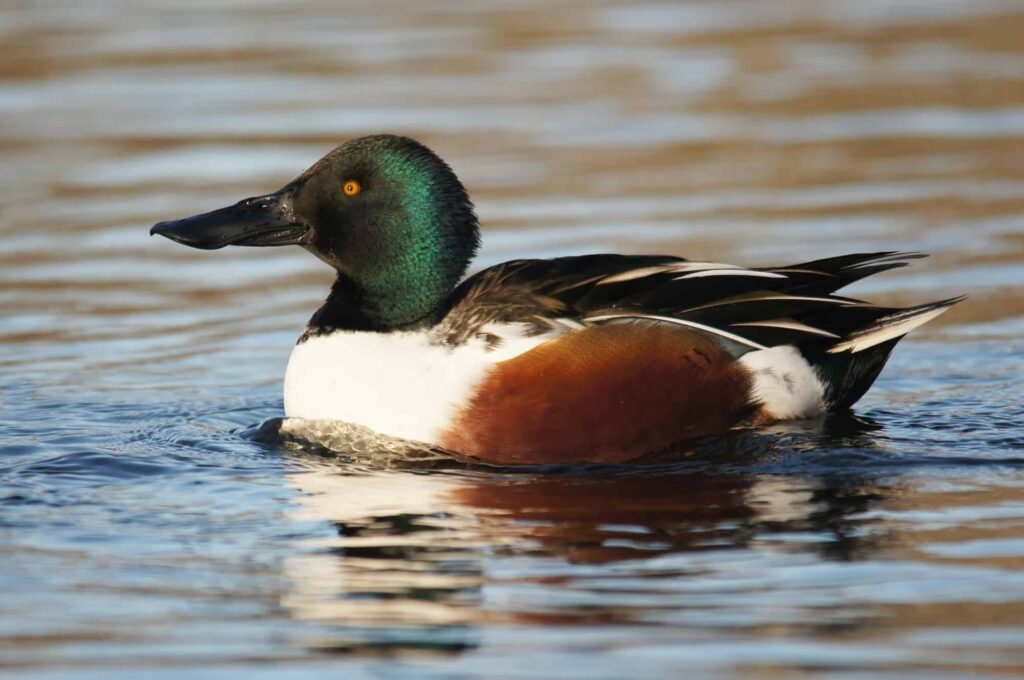Like many other Atlantic Coast states, Massachusetts’ location makes it perfect for spotting many different types of waterfowl in and around the ocean.
From year-round residents to winter visitors and the species of ducks that fill the sky twice every year on their way north, south, east, or west, here’s a list of some of the most common ducks you are likely to see in the Bay State.
For other birds you are likely to see, click here. Unless otherwise noted, measurements are from the Cornell Lab of Ornithology’s All About Birds, which provides bird identification information, fun facts, and more.
Dabbling Ducks
Mallard
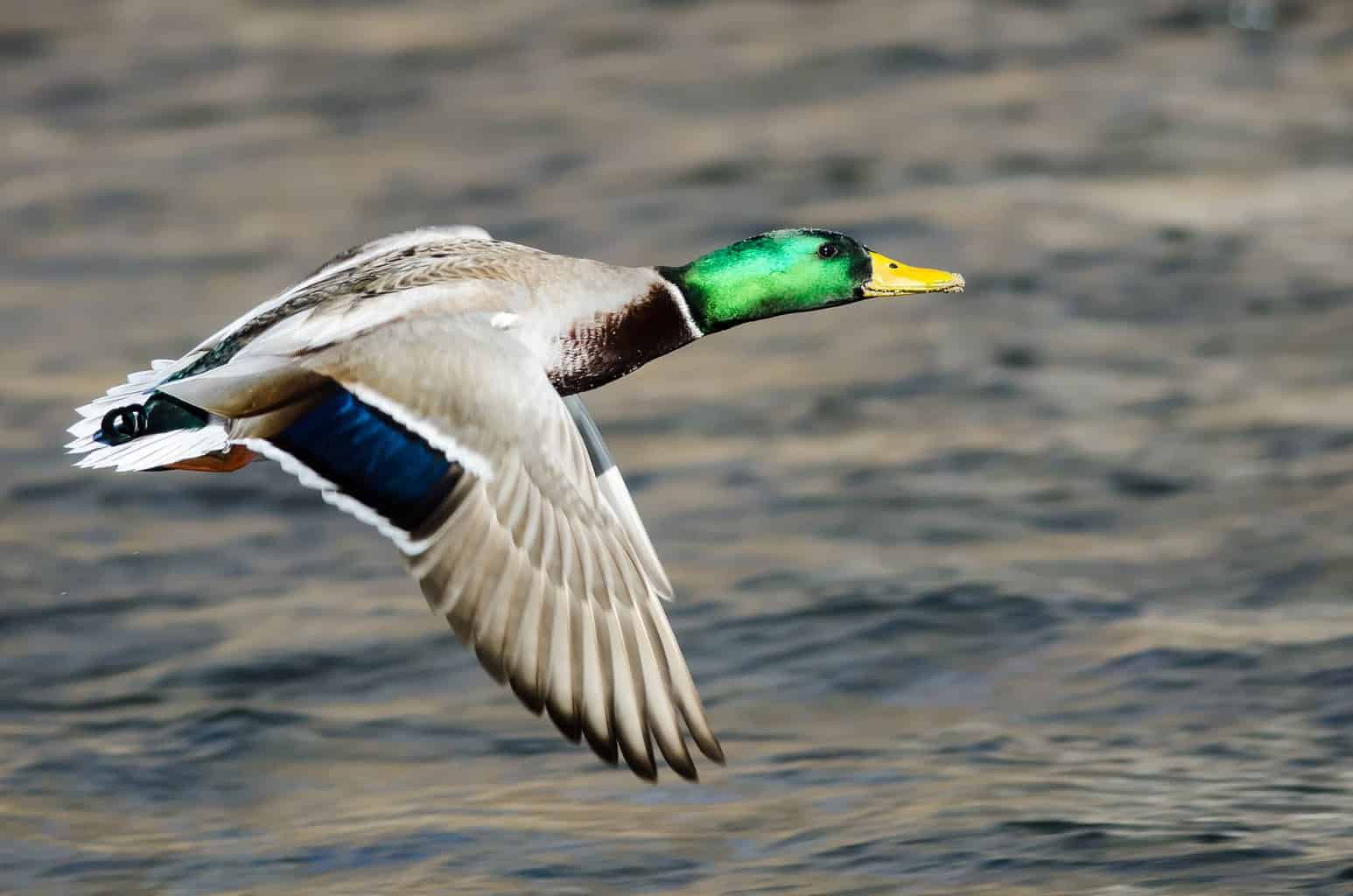
- Anas platyrhynchos
- Length: 19.7-25.6 inches
- Weight: 35.3-45.9 ounces
- Wingspan: 32.3-37.4 inches
Mallards are the most common duck in Massachusetts, according to Mass Audubon, and due to their adaptability to habitats like parks, drainage ditches, and even swimming pools, they’re one of the most frequently seen birds across North America.
Males’ green heads are instantly recognizable for birders and non-birders alike. Females are brown and are often seen in pairs with males. They have orange and black bills with orange feet and a blue wing patch that may or may not be visible when not flying.
Mallards can be found in marshes, wetlands, rivers, and ponds, in addition to areas you might not expect ducks, such as backyards, schools, or parks.
American Black Duck
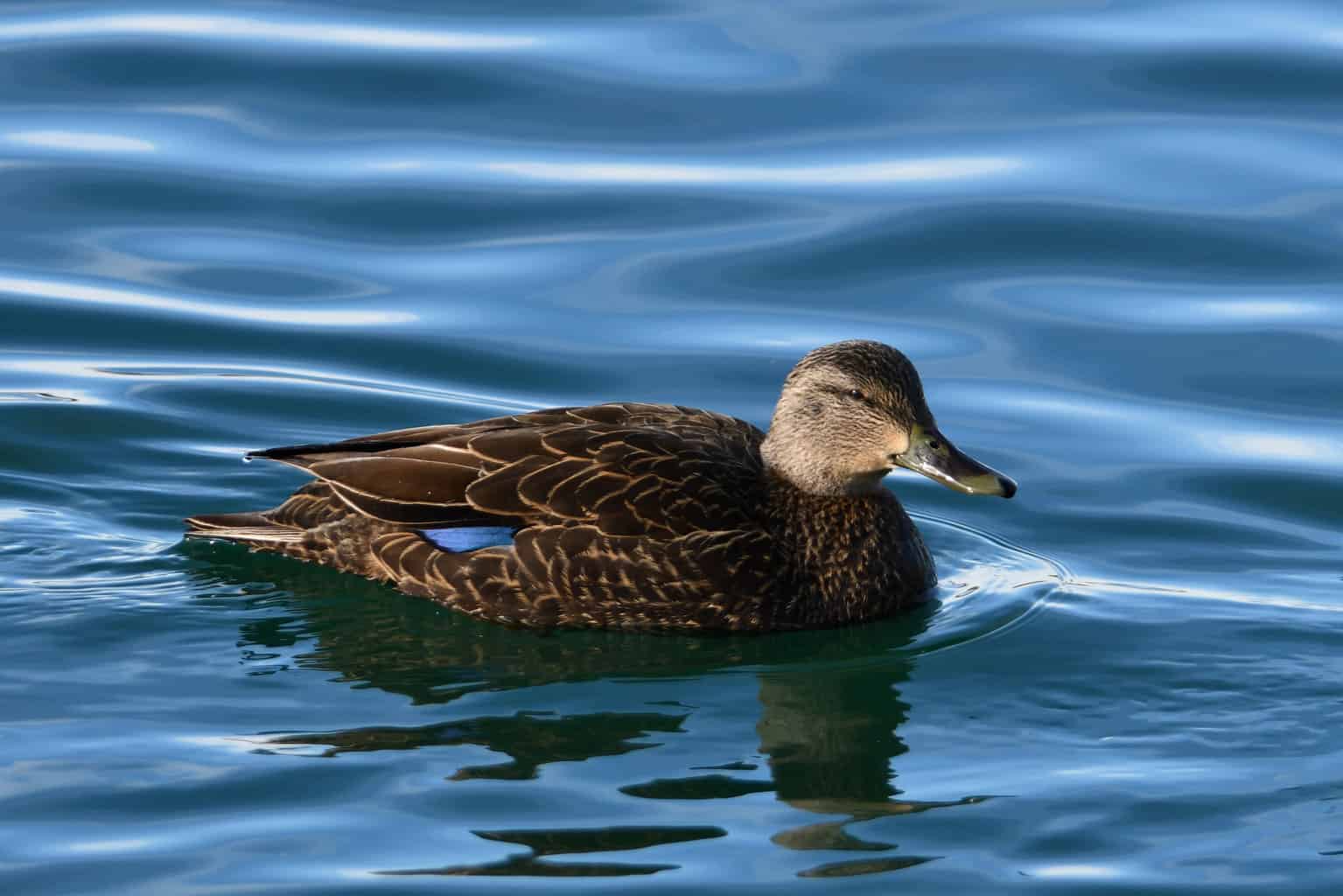
- Anas rubripes
- Length: 21.3-23.2 inches
- Weight: 25.4-57.9 ounces
- Wingspan: 34.6-37.4 inches
American black ducks look similar to female mallards, but with darker plumage across their body. The female has an olive-green bill and males have yellow bills.
In addition to their similar looks, American black ducks frequently hybridize with mallards, which in males can sometimes cause a mix of the mallard’s green head with the brown of the black duck.
These ducks can be found in both saltwater and freshwater in Massachusetts. They’re frequently reported across the state in ponds, marshes, and bays, including populous metro areas like those around Boston.
They can sometimes be found in groups of other waterfowl, including mallards. They are year-round residents of Massachusetts.
Gadwall
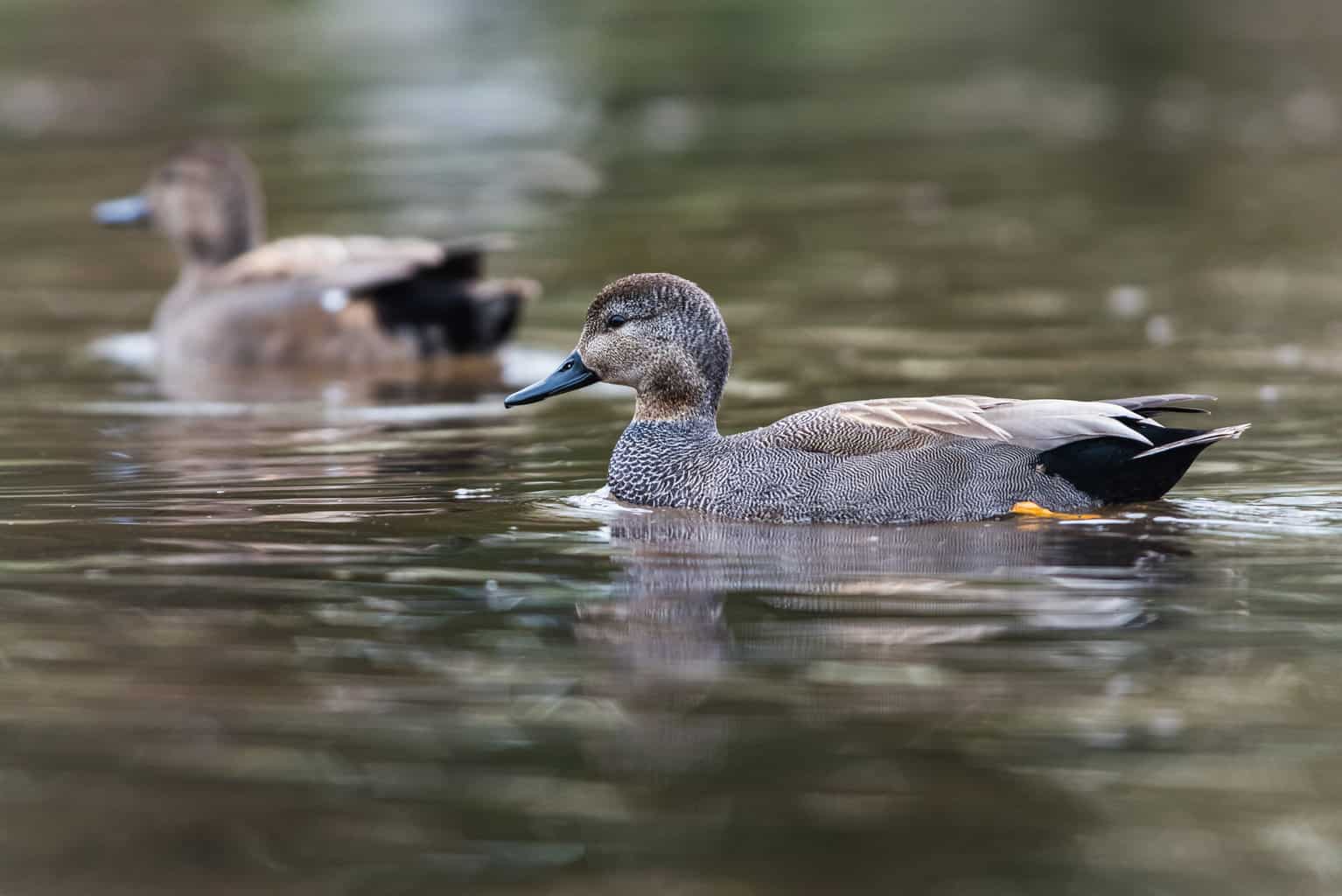
- Mareca strepera
- Length: 18.1-22.4 inches
- Weight: 17.6-44.1 ounces
- Wingspan: 33.1 inches
Gadwall are rare but not non-existent breeders in Massachusetts. Still, their numbers are greater during migration periods and winter, when they may flock to the coasts for open water.
All recorded breeding of gadwall in two Massachusetts breeding bird atlases, according to Mass Audubon, is in the eastern part of the state, while the rest of the state will get a look at them as they move north and south.
Gadwall males aren’t nearly as colorful as some of the others here, but they have delicate patterns of brown, with fine markings from their sides up to the neck. Their heads are light brown, with dark black bills.
In flight, the undersides of the male’s wings are white, and they have black and white wing patches visible both in flight and on the ground.
Females are patterned with brown, similar to mallards and other female ducks. Their bills are a thin black and orange, extending from a steeply-shaped forehead.
Blue-winged Teal
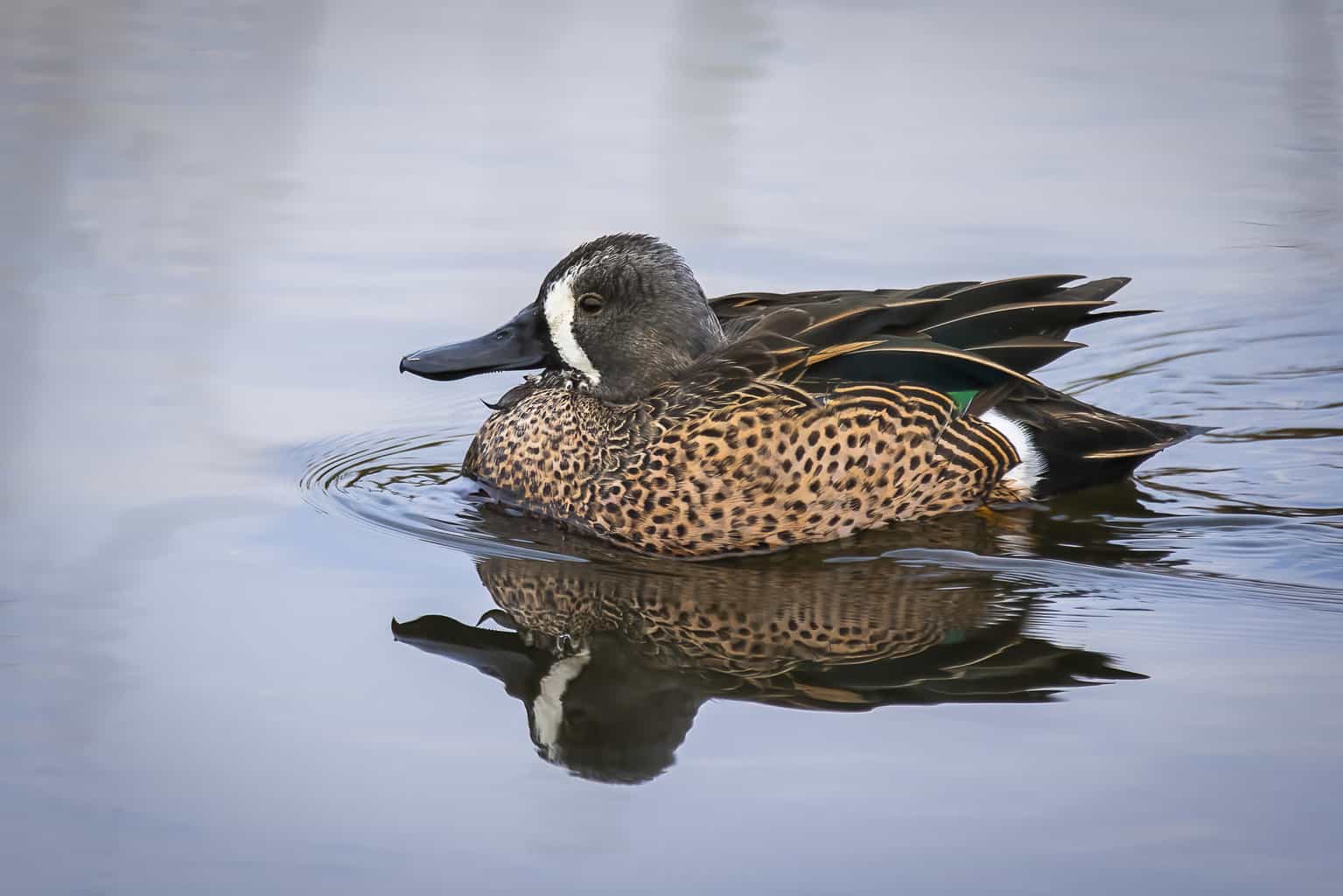
- Spatula discors
- Length: 14.2-16.1 inches
- Weight: 8.1-19.2 ounces
- Wingspan: 22.1-24.4 inches
While blue-winged teal breed in Massachusetts, fewer breeding pairs were recorded in the Massachusetts Breeding Bird Atlas 2, recorded from 2007-2011, than in the previous one. In fact, blue-winged teals are considered “very local and strongly declining,” with “conservation action urgent,” according to Mass Audubon.
Despite this drop in Massachusetts, blue-winged teal populations are generally stable across the continent, though they’re vulnerable to habitat loss like many other duck species.
Their main breeding grounds are in central North America’s prairie pothole region. In Massachusetts, look for them in marshes, wetlands, and small ponds and quiet lakes.
When looking for them, males will stick out more than females, with their blue-gray heads and large white crescent between a black eye and bill. They have speckled brown sides.
While females are an unassuming brown with black bills, they have powder blue wing patches revealed in flight.
Green-winged Teal
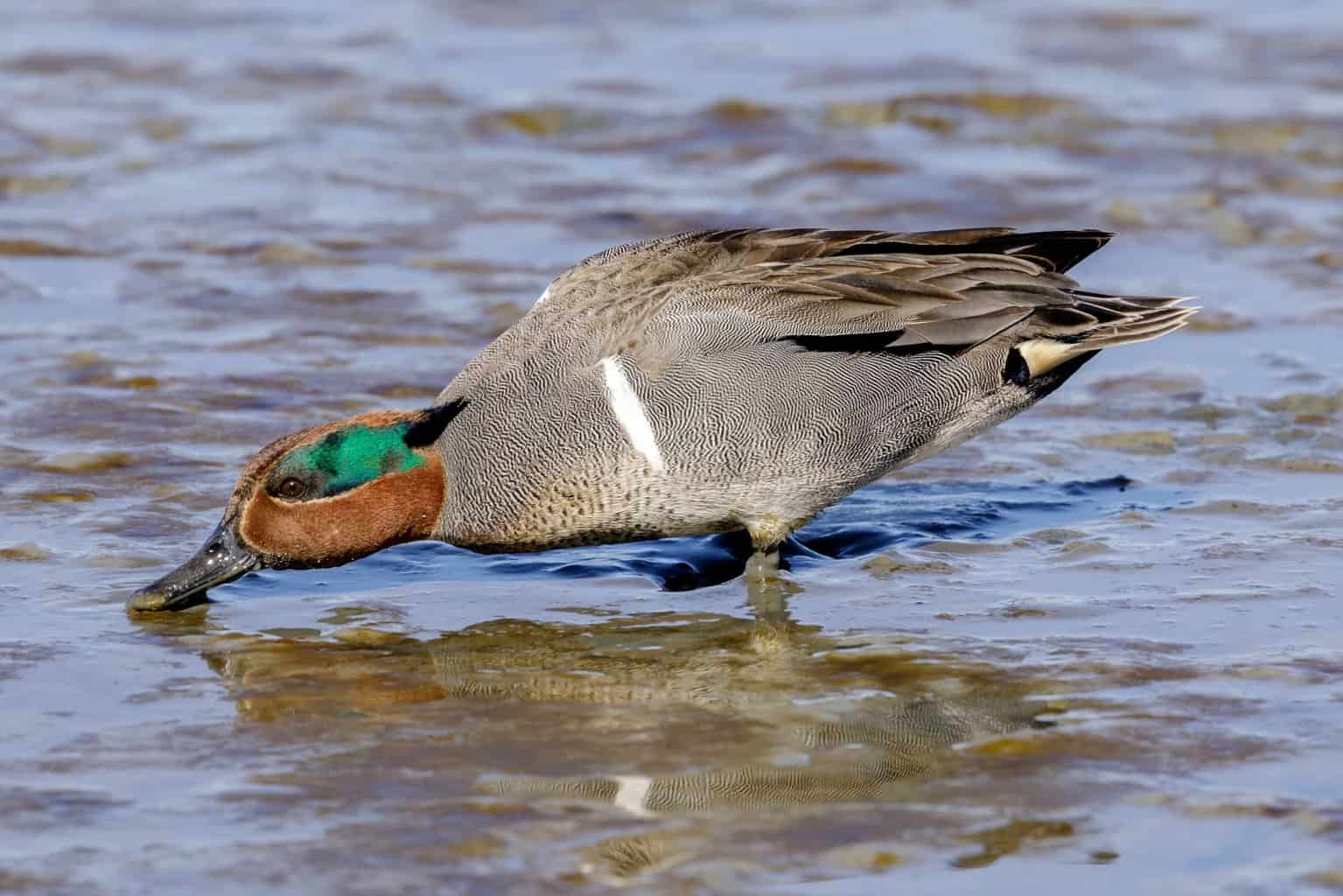
- Anas crecca
- Length: 12.2-15.3 inches
- Weight: 4.9-17.6 ounces
- Wingspan: 20.5-23.2 inches
Massachusetts is on the southern and eastern edge of the green-winged teal’s breeding range, where they breed along rivers, though you may also find them foraging in marshes, farm fields, ponds, and more.
Drakes have gray bodies with a vertical white stripe below the head. Their heads are a chestnut-brown with a green block extending from the eye back down toward the nape.
Females are best recognized by their green wing patches when visible, although they’re not always shown when the birds aren’t in flight.
If you have another bird nearby as a frame of reference, you may also be able to tell just how small the green-winged teal is, which can help you identify one when you’re out birding.
American Wigeon

- Mareca americana
- Length: 16.5-23.2 inches
- Weight: 19.1-46.9 ounces
- Wingspan: 33.1 inches
The Bay State, like most of the United States west of the Mississippi, is not a common breeding territory for the American wigeon, which breeds in the North American west.
Instead, your best time to see wigeons in Massachusetts is during migration, when they’ll be going to or from winter stays along the Atlantic Coast.
Males’ white head cap and green eye stripe, similar to the green-winged teal’s, are two identifying features of this beautiful bird, which also sports rusty brown sides with black and white tail feathers.
Females have gray heads with darker plumage surrounding the eye. They have light brown sides.
Eurasian Wigeon
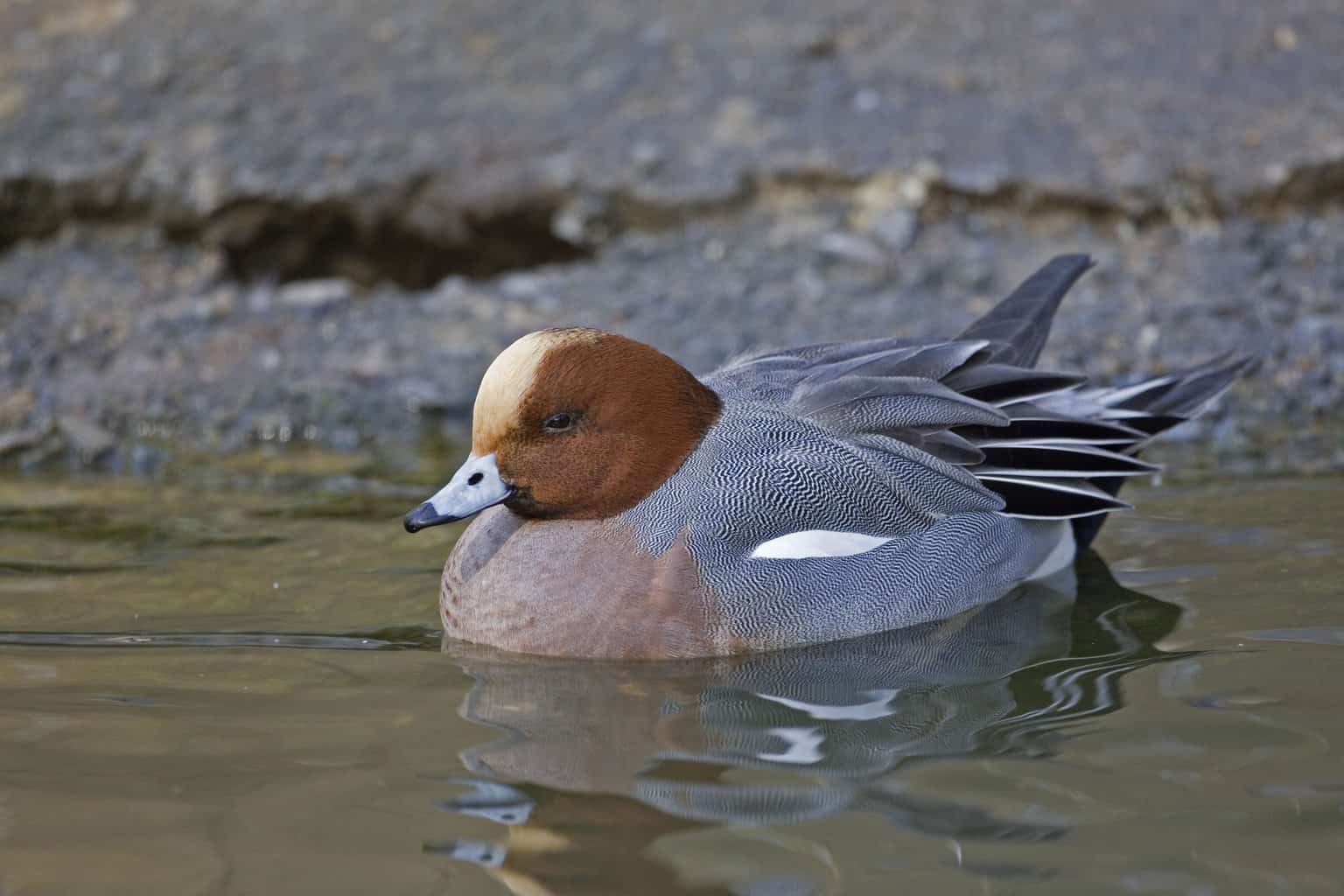
- Mareca penelope
- Length: 17.7-22.8 inches
- Weight: 14.6-34.2 ounces
- Wingspan: 29.5-33.9 inches
(Measurements courtesy of the University of Michigan’s BioKids)
The Eurasian wigeon is a regular winter visitor to portions of North America’s coasts, Massachusetts included. That being said, they’re rare sightings in the state’s bays and sounds in their annual visits from Europe and Asia.
Males have rich, chestnut-brown heads with a tan stripe through the top of the head, similar to the American wigeon’s white stripe. They have patterned gray bodies.
Female Eurasian wigeons are extremely similar to American wigeons in pattern, but they’re a redder brown than their light tan American cousins.
Their patterned eye markings are similar as well, though that’s tougher to see against a darker body.
Northern Pintail
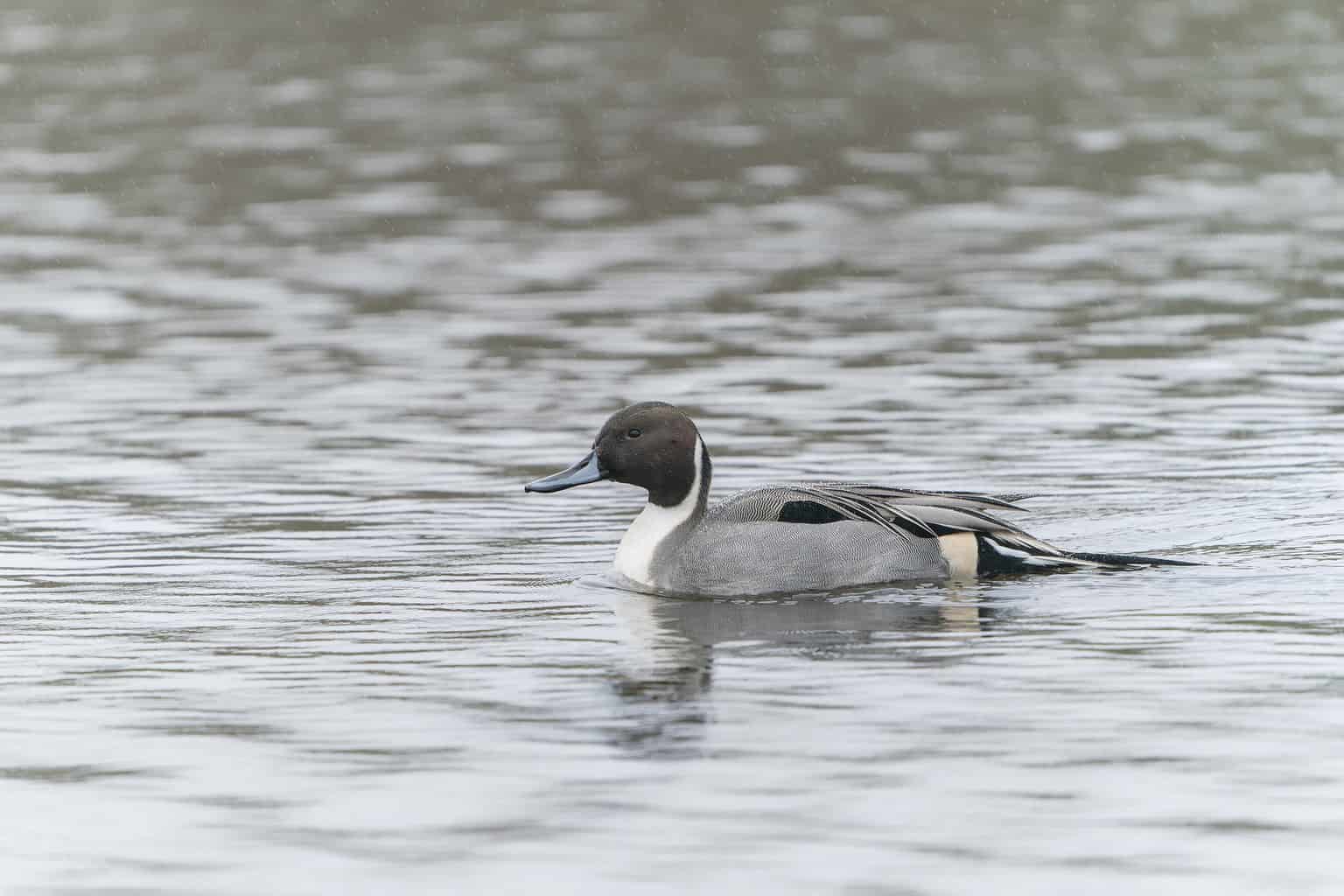
- Anas acuta
- Length: 20.1-29.9 inches
- Weight: 17.6-51.1 ounces
- Wingspan: 34 inches
Pintails are extremely rare breeders in Massachusetts, but they are regular in winter and migratory seasons, largely along the coast, though eBird users regularly report them inland in areas like those along the Connecticut River.
Pintails are seen along wetlands, bays, and marshes, including in groups of other species.
In those groups, the long tail is what separates this duck. Males have brown heads and white necks that meet gray sides. Their tops are a mix of black, white, and tan. Their longest tail feathers are black, angling up vertically from behind them when in the water and sticking straight back in flight.
The only duck with a tail that resembles the pintail’s belongs to the long-tailed duck, a diver we’ll discuss later in this list.
Females have long tail feathers, though they don’t stand out quite as much as those of the males. They have long necks and relatively plain heads and faces compared to most of the other female ducks on this list.
Northern Shoveler

- Spatula clypeata
- Length: 17.3-20.1 inches
- Weight: 14.1-28.9 ounces
- Wingspan: 27.2-33.1 inches
Northern shovelers are primarily seen during migration, with some winter stays along the coast. They are seen most often along the eastern parts of the Bay State, where they occupy shallow marshes and wetlands.
Shovelers’ large bills are used in their search for food and also provide you with your most clear identifier of a northern shoveler in your pursuit of adding one to your life list.
Females look relatively similar to other female ducks, save for a large, orange, shovel-shaped bill.
Males have large brown patches on their sides that are flanked by white on either end, as well as a green head, yellow eyes, and a large black bill.
Wood Duck
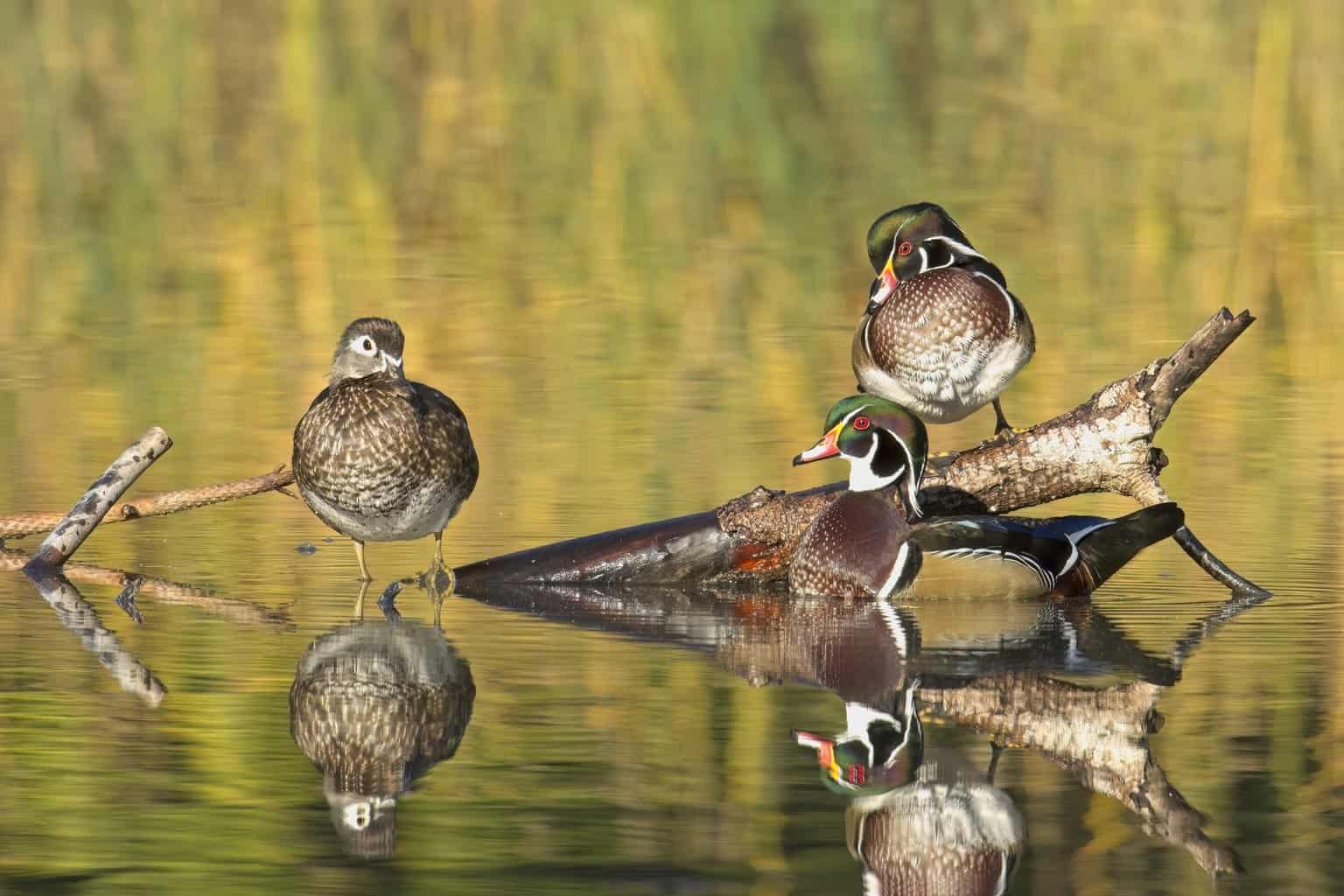
- Aix sponsa
- Length: 18.5-21.3 inches
- Weight: 16-30.4 ounces
- Wingspan: 26-28.7 inches
The last of our dabbling ducks is certainly not least in terms of its unique appearance or its status amongst the most common year-round Massachusetts ducks.
Wood ducks spend all year in the Bay State, often around wooded lakes and rivers. They’re cavity nesters, meaning they nest in holes in trees or snags. It also means they’re one of the most likely ducks to utilize duck nesting boxes.
Duck nesting boxes can either be purchased or built. For the National Audubon Society’s build guide, click here.
Wood ducks are best identified by their head crests. Males have green heads adorned with painted whites, as well as rich brown chests and tan sides.
Females, while lacking much of the color flare, have gray-brown heads with a white ring around the eye. The female’s head ends in a crest just like the male’s.
Ducks That Dive
Redhead
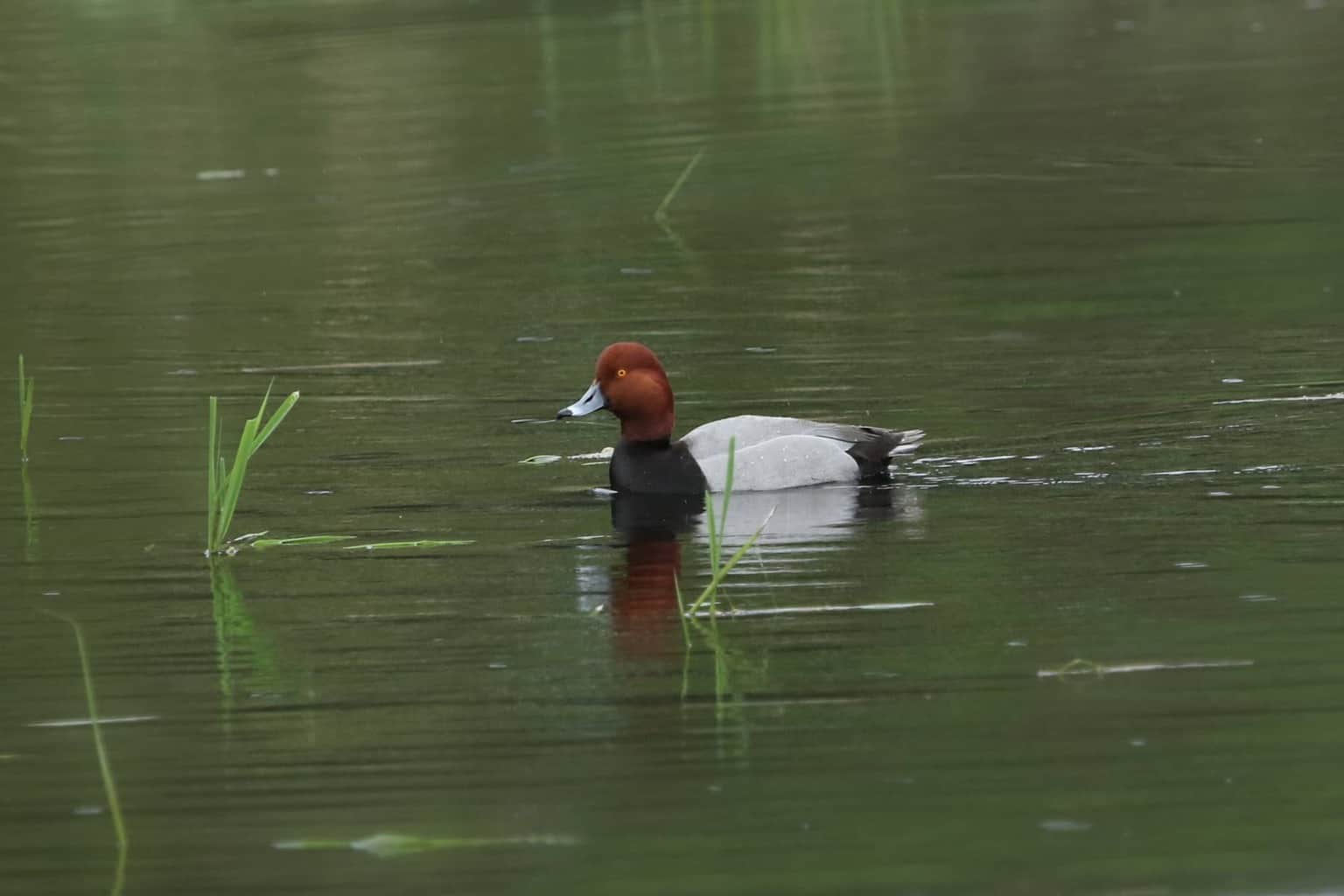
- Aythya americana
- Length: 16.5-21.3 inches
- Weight: 22.2-52.9 ounces
- Wingspan: 29.5-31.1 inches
Redheads breed through western North America’s prairie pothole region, as well as a stretch around lakes Erie and Ontario.
Massachusetts isn’t a hotbed for redhead visitors, even during winter and migration, but your best shot to see them is along the coasts and water bodies nearby, including bays, saltwater marshes, and ponds just off the ocean.
Redhead males have heads of cinnamon red, along with crisply defined sections of black on the neck and chest and gray along their sides.
Female redheads are almost all brown, darker on top and lighter along their sides. Their dark gray bills are tipped in black.
Canvasback
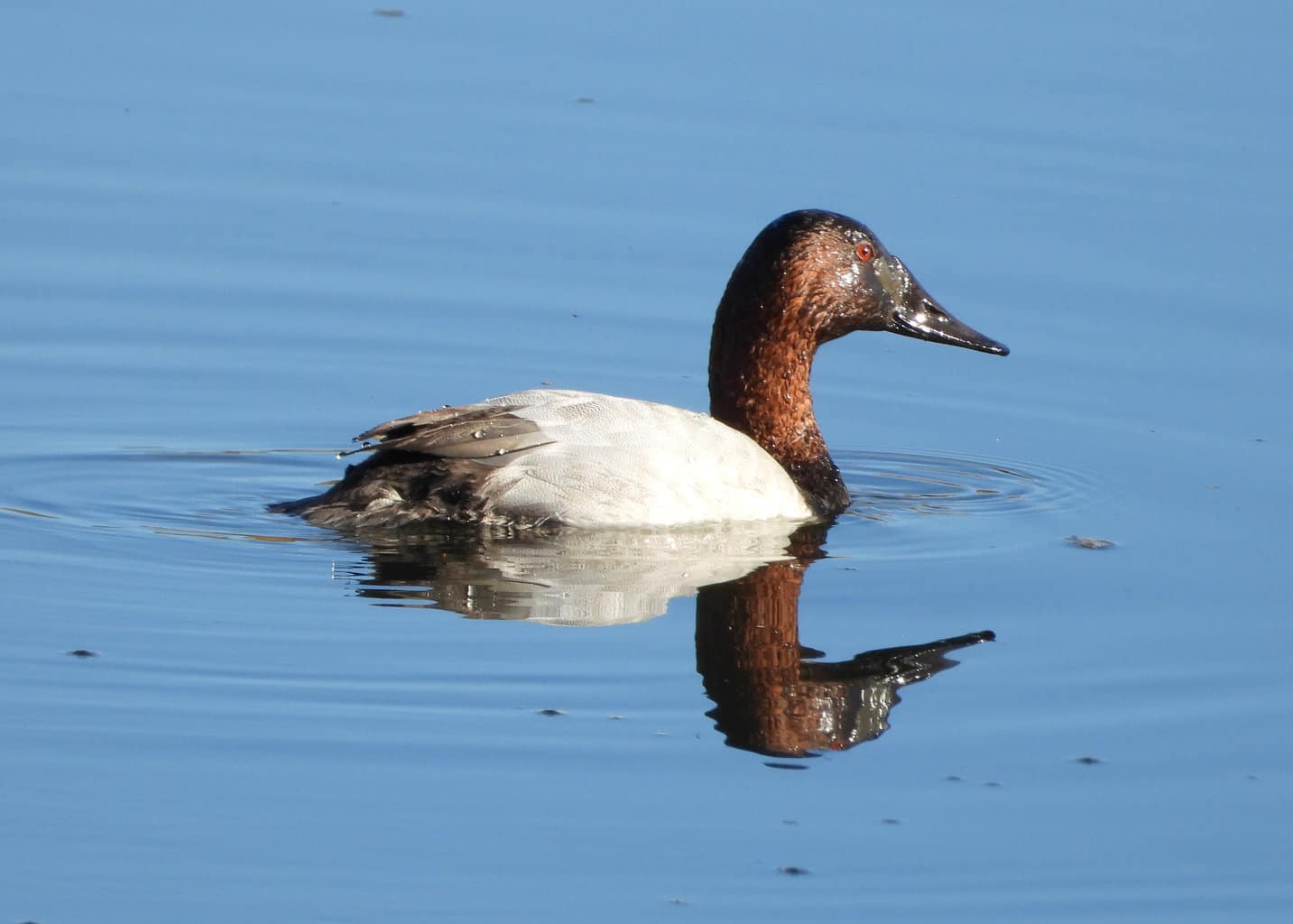
- Aythya valisineria
- Length: 18-9-22.1 inches
- Weight: 30.4-56 ounces
- Wingspan: 31.1-35 inches
Canvasbacks, male and female, are the most visually similar birds to redheads, and they are most likely to be seen in similar places to redheads, primarily around eastern Massachusetts and areas around the coast.
Males have red heads with bright red eyes and black bills. Their chests are black, with white sides and back in place of the redheads’ gray.
Canvasbacks are, on average, a bit larger than redheads, with foreheads that slope down at a less sharp angle than the redhead’s steep forehead and gray bill. This can help you tell apart both male and female canvasbacks and redheads.
Females have pale, gray sides instead of the canvasbacks’ darker brown.
Greater Scaup
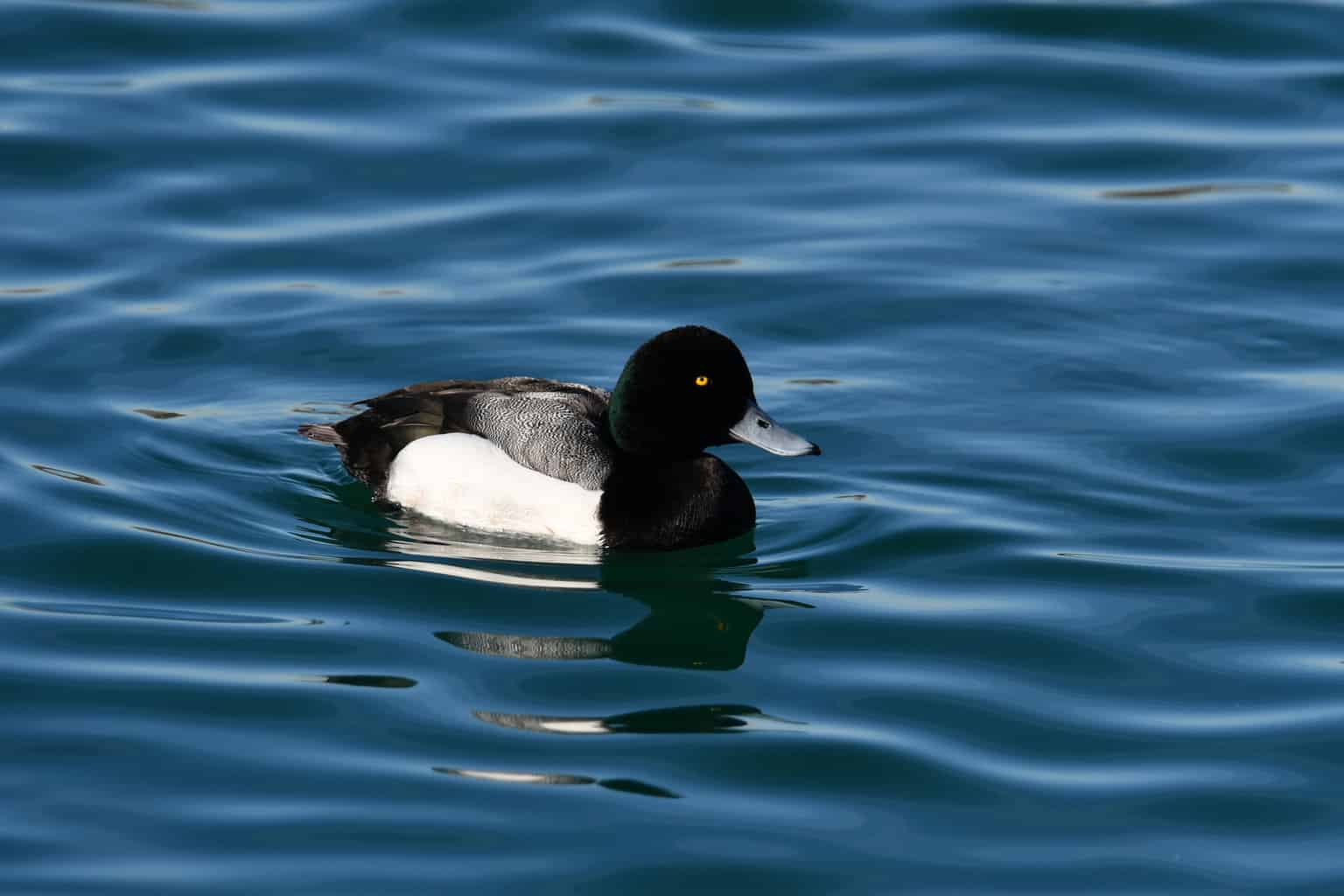
- Aythya marila
- Length: 15.3-22.1 inches
- Weight: 25.6-48 ounces
- Wingspan: 28.4-31.1 inches
Scaup are medium-sized diving ducks that breed in the tundras of Northern America and move south, often along the coasts and Great Lakes, to spend the winters.
Worldwide greater scaup numbers have rapidly declined, but they’re still often seen in large groups in Massachusetts’ coastal bays, including around Boston.
Male greater scaup have white sides, gray patterned topsides, and iridescent green heads. Their gray bills have small tips of black.
Females are brown all over. Their distinguishing markings can be found on the head, where they have yellow eyes and a gray bill that’s surrounded at the base by a thick white ring.
Lesser Scaup
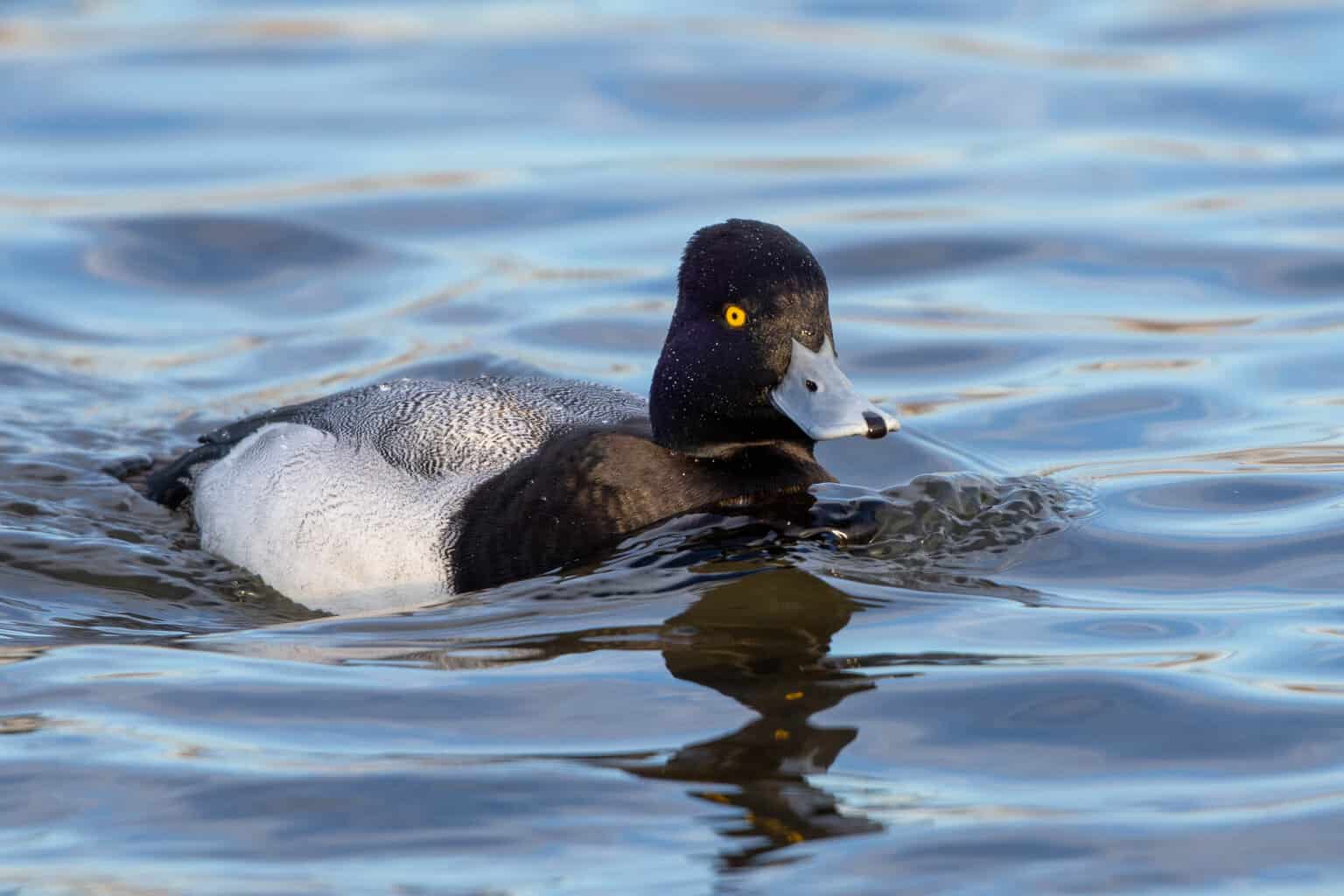
- Aythya affinis
- Length: 15.3-18.1 inches
- Weight: 16-38.4 ounces
- Wingspan: 26.8-30.7 inches
Lesser scaup breed mostly in the western half of North America, most commonly north of the Canadian border, before heading to the south and the coasts for winter.
Mass Audubon describes lesser scaup as a “fixture in our winter-duck community,” with the sightings at the annual Christmas Bird County on a slight uptick recently, though still much lower than in the 1970’s. They’re most commonly spotted in ponds around the coast.
Lesser scaup and greater scaup look quite similar. Lesser scaup have iridescent purple heads visible in good lighting. They have a less rounded head than the greater scaup’s.
As scaup often flock in large groups, it’s often quite difficult to tell the difference between the two species, especially at a distance. For more clues about the differences between greater and lesser scaup, head over to the National Audubon Society’s website.
Ring-necked Duck
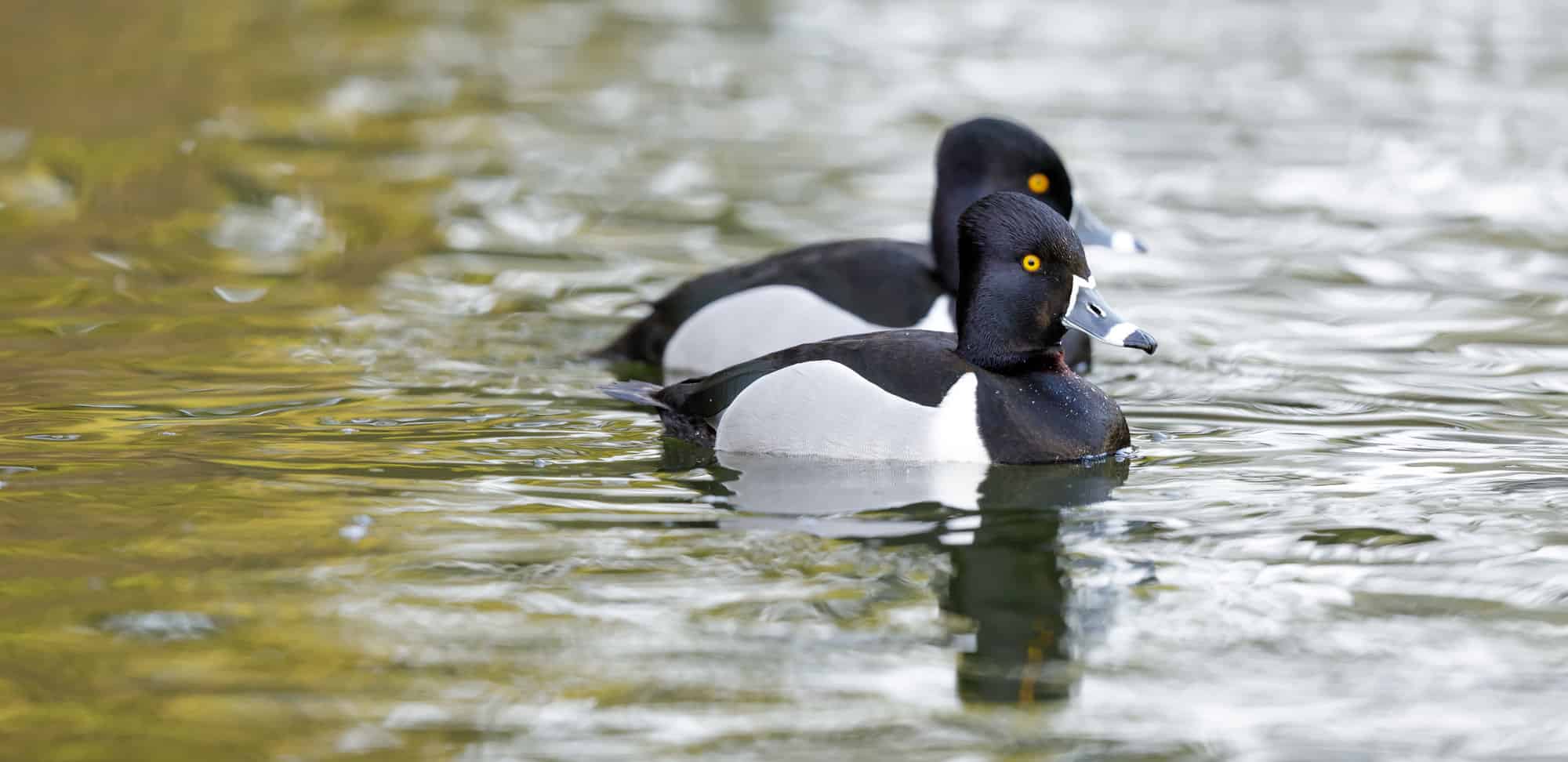
- Aythya collaris
- Length: 15.3-18.1 inches
- Weight: 17.3-32.1 ounces
- Wingspan: 24.4-24.8 inches
Similar in color to scaup is the beautiful ring-necked duck, another common migrant through the state each year.
According to Mass Audubon, peak spring migration is usually in April, with some birds hanging around until May or early June. They will typically return in mid-fall, setting up shop in ponds, lakes, and marshes across the state.
Despite their name, the ring around the ring-necked duck isn’t the best way to identify one in the field.
On breeding males, look for a mostly black male with light gray sides with a unique gray bill, tipped in black with two white rings, one at the base and the other just before the black tip.
Non-breeding males have the same pattern, with gray sides and mostly black everywhere else, though their sides go from a crisp gray color to a dull, dirty-looking shade.
Females have brown sides where the males are gray, with a darker brown on top and light gray, peaked heads. They have a thin white eye ring. Their gray bills have one ring before a black tip, and they have a thicker ring of white plumage around the base of the bill, similar to scaup.
Common Goldeneye
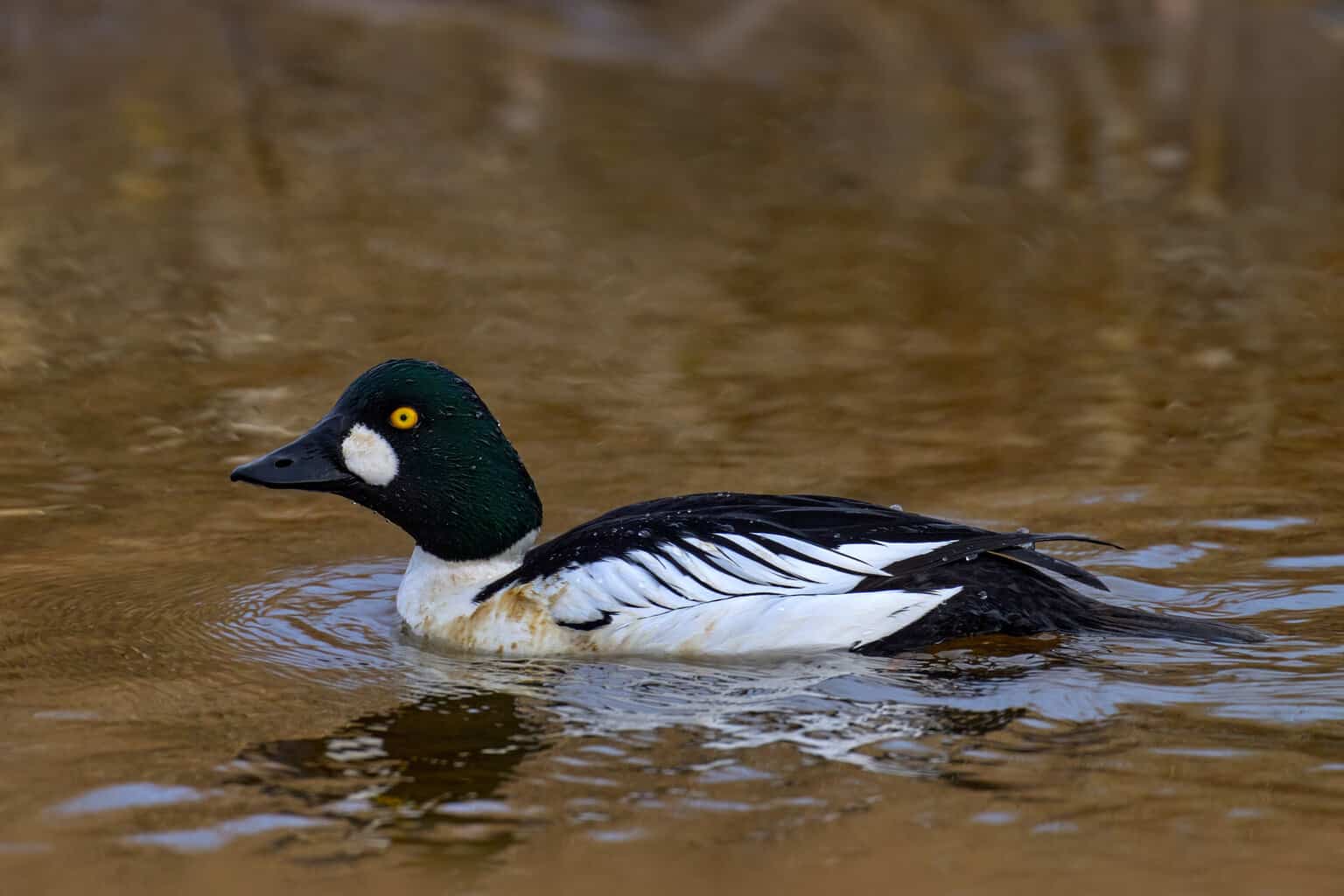
- Bucephala clangula
- Length: 15.8-20.1 inches
- Weight: 21.2-45.9 ounces
- Wingspan: 30.3-32.7 inches
Common goldeneyes are primarily Canadian residents, but much of the United States has a chance to get familiar with these divers during the winter months.
Goldeneyes are most common in Massachusetts near the coast, although other larger bodies of water throughout the state receive regular visits, such as Wachusett Reservoir, where they are sometimes reported by eBird users in big groups.
If you’re near the ocean, look for them in water protected from the waves, including harbors and protected bays.
Male goldeneyes have iridescent green heads with yellow eyes and black bills. Just in front of that bill is a fairly large white circle. Their black backs and crisp white sides meet a section of white barring.
Females are typically slate gray with a chocolate-brown head. Like males, they have golden eyes. Their black bills are tipped in light orange.
Barrow’s Goldeneye
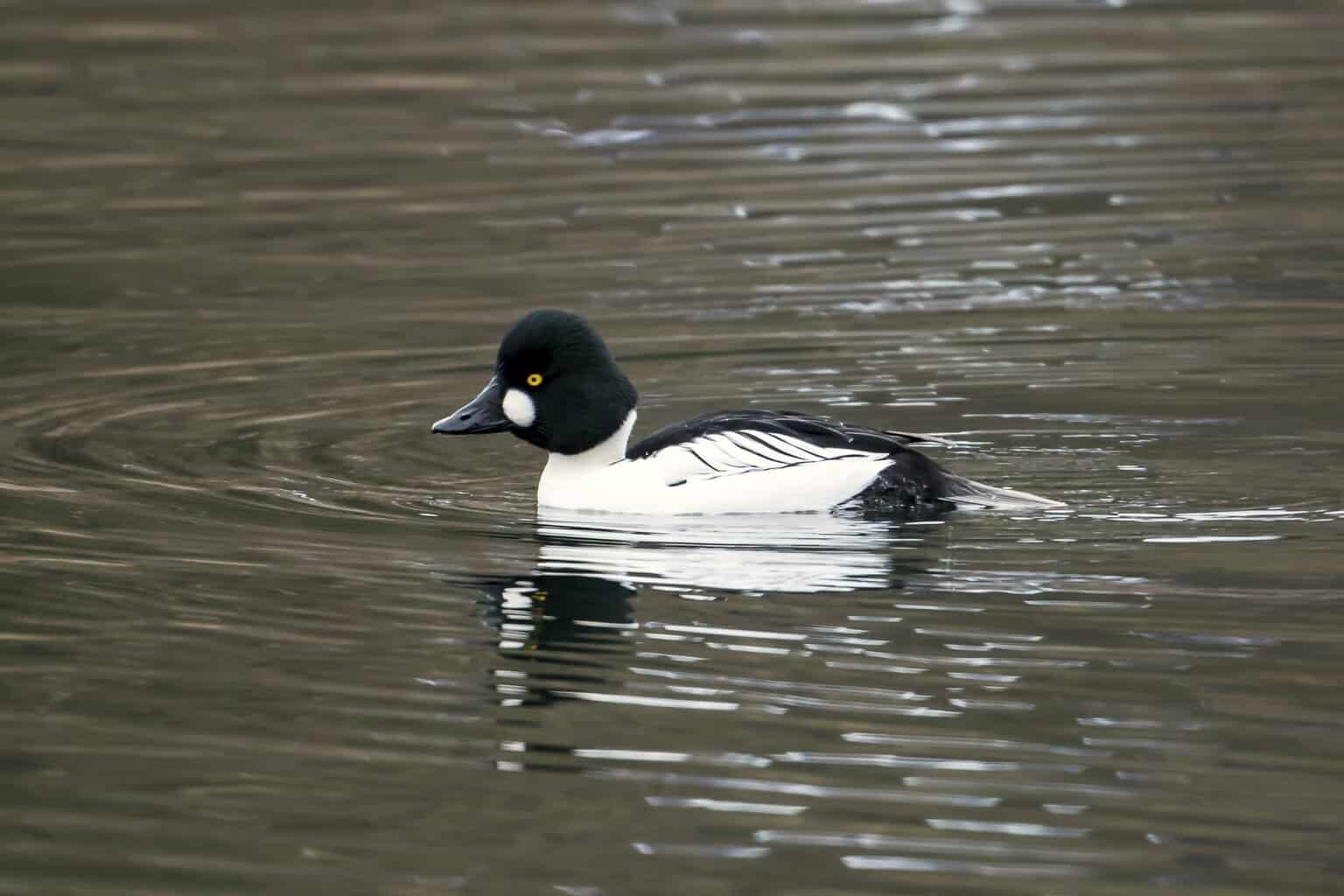
- Bucephala islandica
- Length: 16.9-19.1 inches
- Weight: 37.9-46.6 ounces
- Wingspan: 27.6-28.7 inches
The less common cousin of the common goldeneye, Barrow’s goldeneyes regularly winter in Massachusetts, although catching a glimpse of one is a rare feat.
Throughout the 2022-23 winter, one was regularly reported on eBird around Castle Island and Pleasure Bay near South Boston. Other bays and coves around the area also give you a chance to see one, as rare as they may be.
Males can be told from common goldeneyes by the shape of their white facial marks. While the common goldeneye’s markings are very circular, Barrow’s goldeneyes have a longer patch. Sometimes it will hook upwards in a crescent shape, while others will look more like a teardrop.
Where the common goldeneye has longer white bars, the Barrow’s goldeneye’s white markings are usually a bit smaller, and their heads have a purple iridescent sheen.
Females are, unfortunately, a little bit more difficult to tell apart, with small but key details in the birds’ bill and head shapes. Barrow’s goldeneyes have a shorter, stubbier bill that’s often more yellow than the common’s.
Barrow’s goldeneyes have a head that can appear sort of odd-shaped, with a peak at the forehead and a gradual slope backward into a blocky back. It’s not rounded like most ducks, and it’s not quite a crest like the wood duck, for example.
Bufflehead
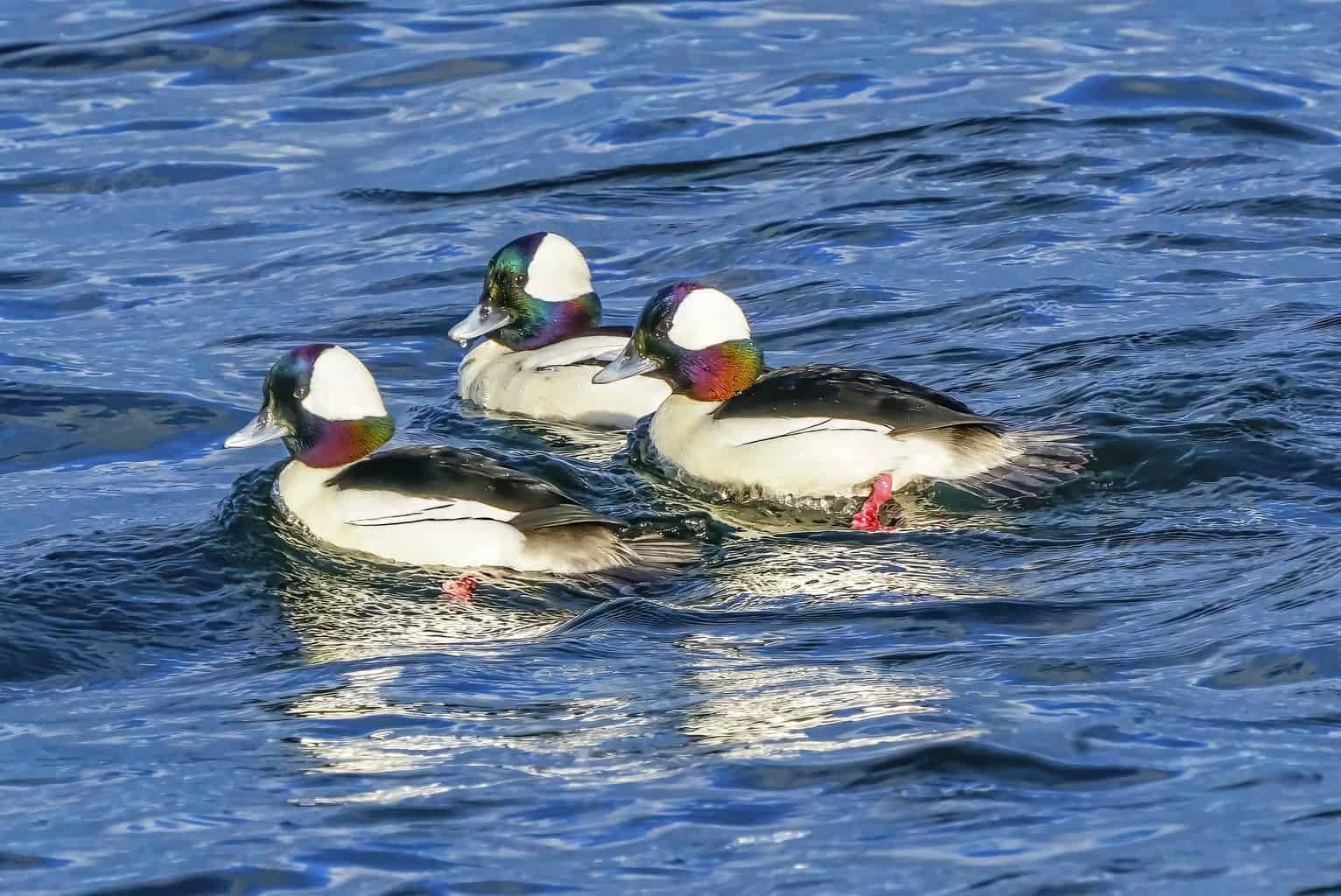
- Bucephala albeola
- Length: 12.6-15.8 inches
- Weight: 9.6-22.4 ounces
- Wingspan: 21.6 inches
Next on our list is a unique little diving duck, the bufflehead, which can be as small as a foot long.
Buffleheads are not Bay State breeders, but they frequent the state during migration and winter each year, showing up in coastal bays, marshes, rivers, and lakes throughout the region.
It’s very common to see them in pairs or small groups, diving down for their favorite food and popping back up shortly afterwards.
Adult males have white sides and black topsides, but what really stands out is the round, distinctly-patterned head. Much of the face is iridescent purple, blue, and green, but could appear black in many lighting conditions. On the back of the head is a large pie slice of crisp, clean white taken out of the rest of the colorful head.
In flight, they also reveal strong white lines on the shoulders and a large white section mid-wing.
Both females and immature males are picked out by a white cheek patch that looks as though someone took their thumb and wiped a patch of color off the side of the bird’s face.
Females don’t have the large white wing markings that males do, but their brown bodies do have a smaller white patch visible on the topside. When seen in the water, you can sometimes see the little white patch starting to peek out.
Ruddy Duck
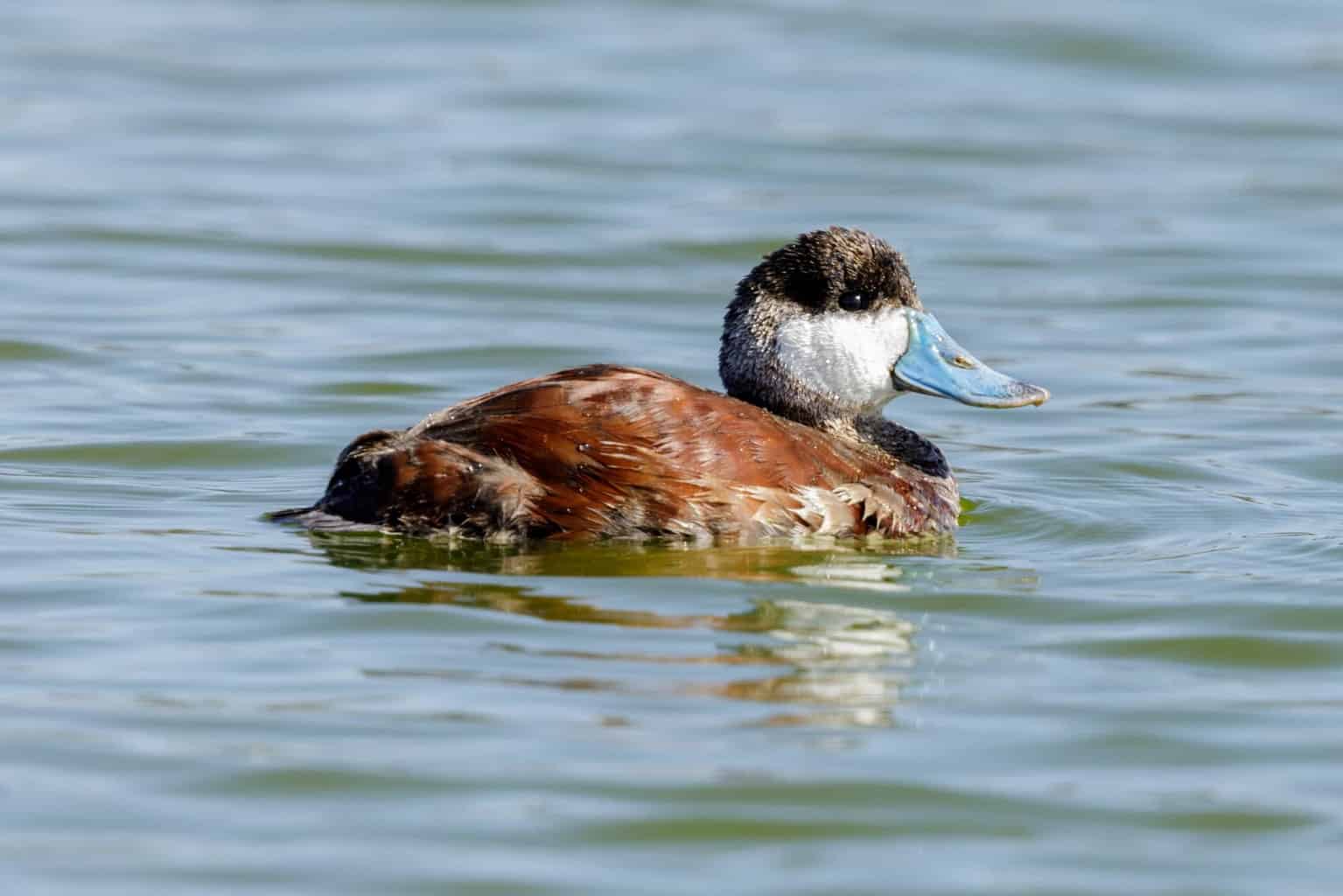
- Oxyura jamaicensis
- Length: 13.8-16.9 inches
- Weight: 10.6-30 ounces
- Wingspan: 22.1-24.4 inches
From one little diver to the next, the ruddy duck is another one of North America’s smallest ducks.
Ruddy ducks used to regularly breed in Massachusetts, according to Mass Audubon, which cites a 1912 report from Edward Howe Forbush, but that has not been the case for some time.
Now, birders in the state have the best chance to see them during migration as they head to coasts a little further south. Others will winter in protected waters near the coast.
Ruddy ducks are not just unique for their small stature, either. Breeding males have powder-blue bills unlike any other North American duck, but non-breeding males will see that bill fade to a dark black.
In breeding plumage, males are a rich, deep, brown color, with black napes and heads. A large portion of their face is white. That white portion remains in their non-breeding plumage when the rich brown fades to a dull color. Their caps, while not quite the jet black they were at their sharpest, are still much darker than the rest of the body, just like in their full color.
Both males and females have long tails that may or may not be sticking straight up out of the water. Other times, it’s tucked away as they sleep or dive underwater in search of food. While it’s long, it’s not as sharply-pointed as the pintail or long-tailed duck (next on this list). It’s more of a wider shape.
As for their color patterns, females are largely a dull brown, with a darker cap and a slightly darker stripe below the cap.
Long-tailed Duck
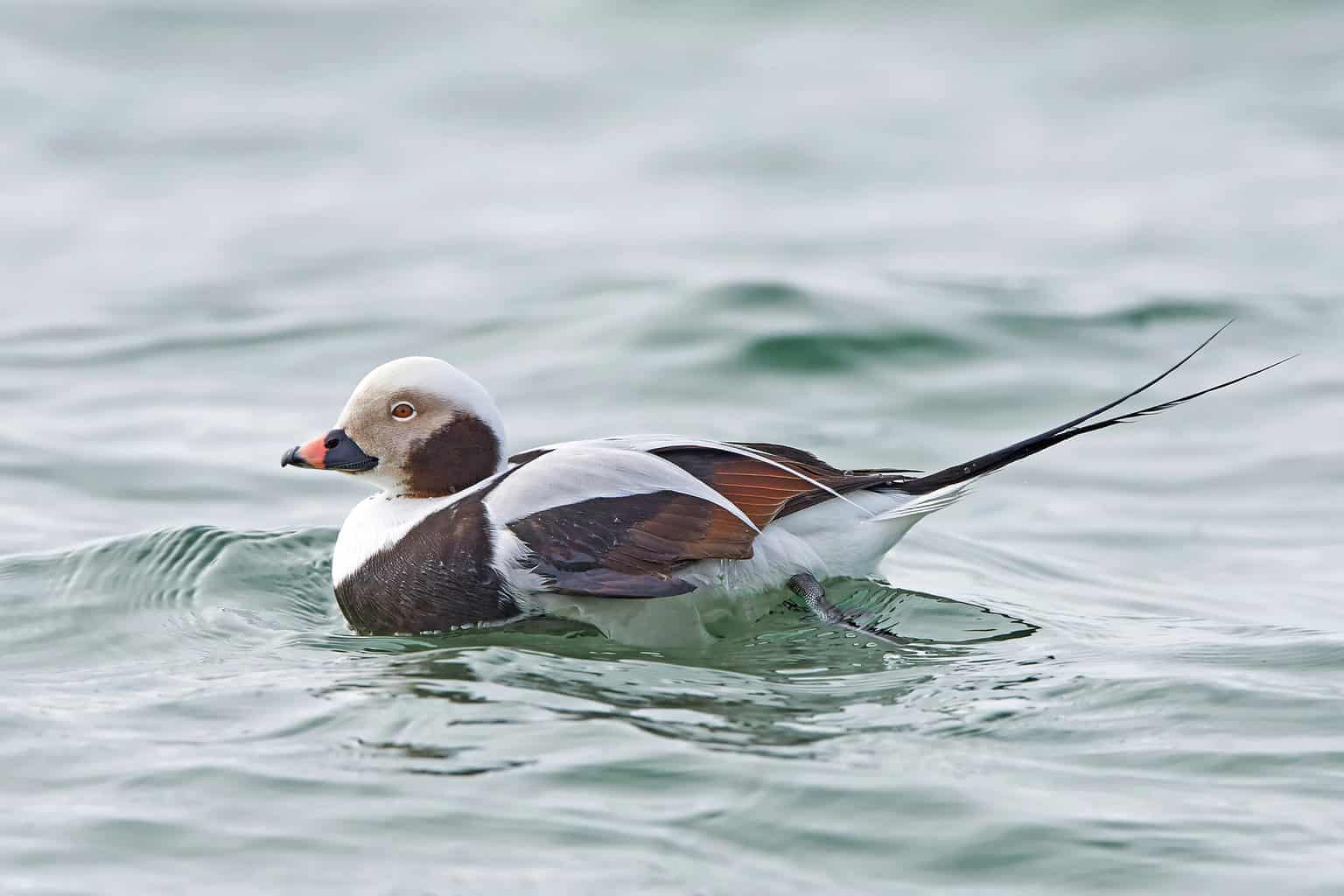
- Clangula hyemalis
- Length: 15.8-18.5 inches
- Weight: 22.9-38.8 ounces
- Wingspan: 27.9-28.4 inches
Long-tailed ducks are breeding residents of the tundra, and they don’t bolt for the warmth during the winter, instead opting for open water around areas like the Great Lakes and northern coasts.
In Massachusetts, you’ll find them almost exclusively around the ocean, where they flock in large numbers during the winter. Among the top places to view them is Nantucket Island, where eBird users regularly report them in groups of hundreds at a time.
Long-tailed males’ tails either stick straight out behind them, such as in flight, or they may curve upward.
They have as interesting a change in plumage as any bird on this list. In non-breeding plumage, males have white caps, a light gray face, and a dark chest and back, which is interrupted by long, white plumes. This is how residents of Massachusetts would see them, as they look like this from November to April, according to the Sibley Guide to Birds.
In breeding plumage, the gray spot on the face becomes the lightest part of the duck’s head and neck area, as everything else becomes quite dark. A brown body is sparsely covered by brown plumes.
Non-breeding females don’t have long tails to help you identify them. They have brown bodies that meet with white halfway up the neck. Their white heads are covered with light brown markings that may make them appear dirty, with one larger brown smudge on the side of the face.
Females in Massachusetts would be seen in this pattern, but as they move into their spring colors, they will turn browner overall, including much of the face, save for a white ring around the eye that extends a little way back toward the rear of the head.
Harlequin Duck
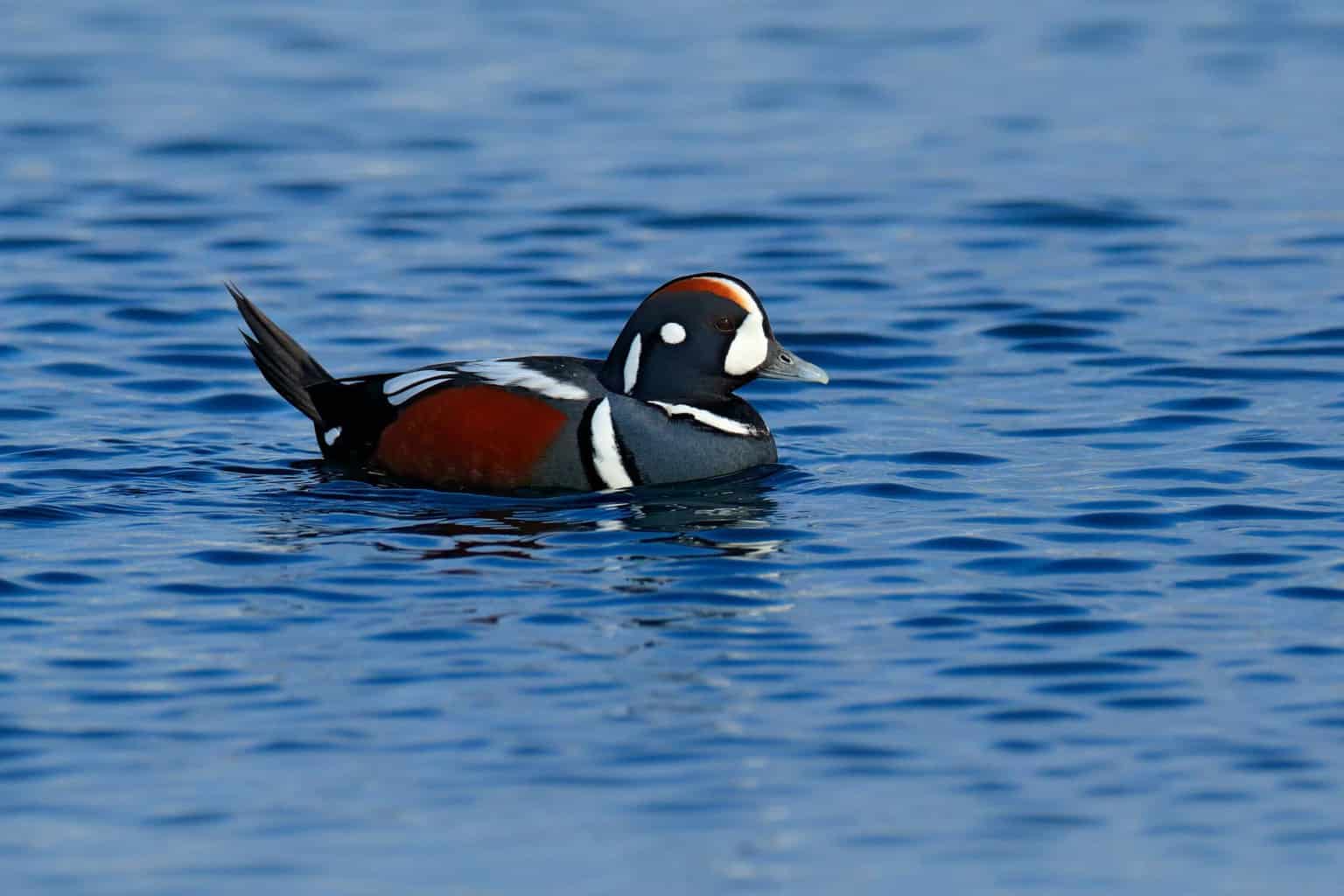
- Histrionicus histrionicus
- Length: 13.4-18.1 inches
- Weight: 17.3-26.8 ounces
- Wingspan: 22.1-26 inches
Harlequin ducks winter on rocky coastlines along the Pacific Northwest and the northern Atlantic.
If you really want to see harlequin ducks in large numbers, your best bet is to head up to Maine. According to the Cornell Lab of Ornithology’s All About Birds, more than half of the eastern harlequin duck population winters along the Maine coast.
Still, states a little farther south still have the potential to produce a sighting or two each winter. Find a rocky area on the shore and pull out the binoculars or spotting scope to see this small sea duck.
Harlequin ducks, at least breeding males, are strikingly beautiful birds, with their blue-gray coloring and intricate, uniquely-placed white, black, and red-brown markings.
In their first winter, males have the resemblance of breeding males, but their markings just aren’t quite as sharp and defined. A dull gray-brown body doesn’t do much to resemble the breeding males, but you can start to see where their white and blue colors will be around the front of the body. Their faces have white markings, just not as crisp as the breeding adults.
Females are mostly all brown, with a couple of marks along the face that remind you of the male: one being a white circle near the back of the head and the other around the bill and eye.
Common Merganser
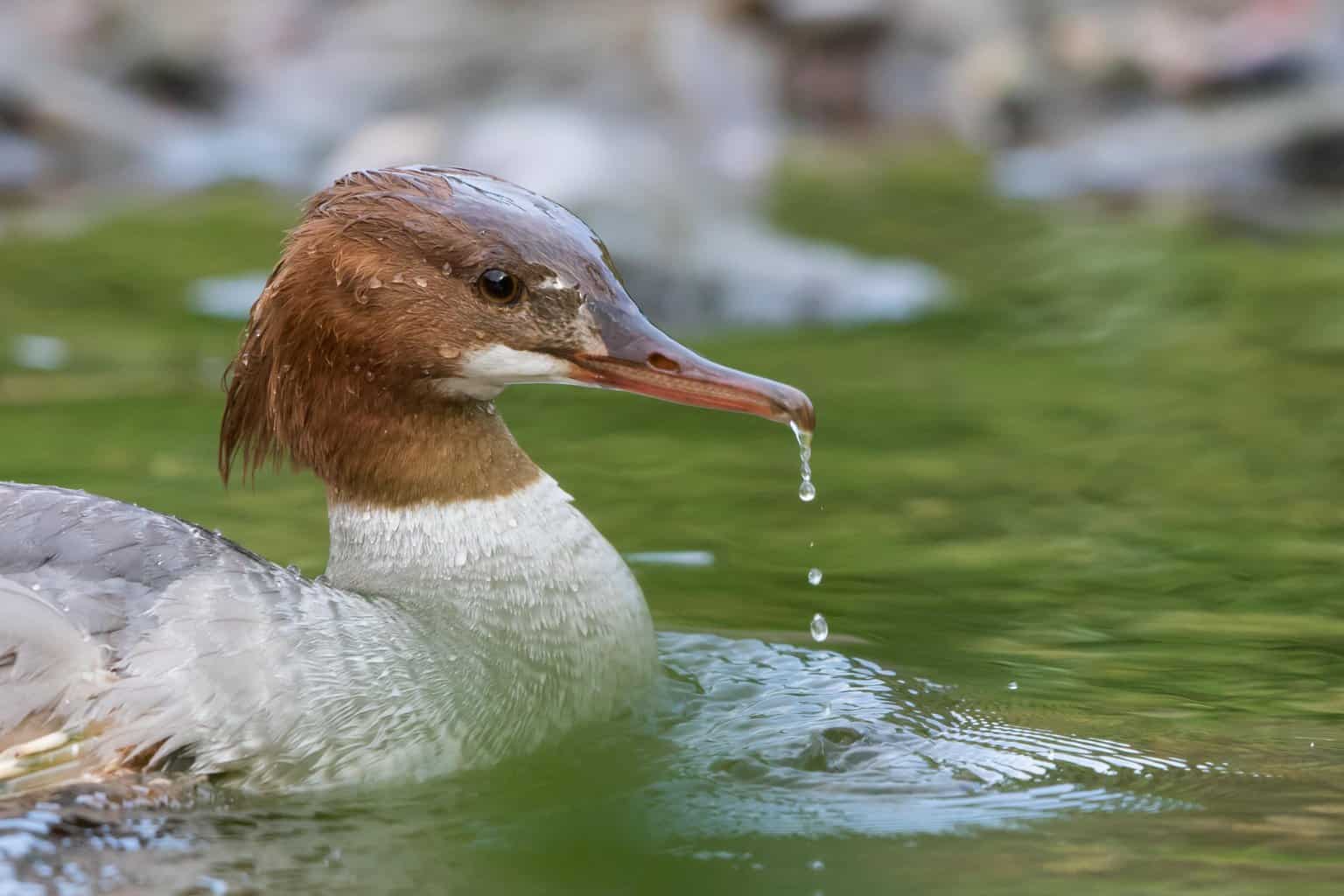
- Mergus merganser
- Length: 21.3-27.9 inches
- Weight: 31.8-76.2 ounces
- Wingspan: 33.9 inches
Once a more frequent breeding resident of Massachusetts, breeding for common mergansers in the state is rare. According to Mass Audubon, a few pairs breed at Quabbin Reservoir, but their breeding range is very limited within the state.
If you’re hoping to catch a glimpse of them, don’t fear. The winter is a great time to see common mergansers in the Bay State, when they could be found anywhere there’s open water for them to dive in search of fish and other food.
It’s not uncommon to see them in groups of other diving ducks. In these groups, their long bodies will surely stick out.
Males’ bodies are mostly white except for some black on top. They have a clean neckline where white meets a sleek green head, from which a long, thin, red bill contrasts sharply.
Females also have a red bill, with red-brown heads against mostly gray bodies. Important to note when identifying a female common merganser from a female red-breasted merganser is a white section near the bird’s chin.
Red-breasted Merganser
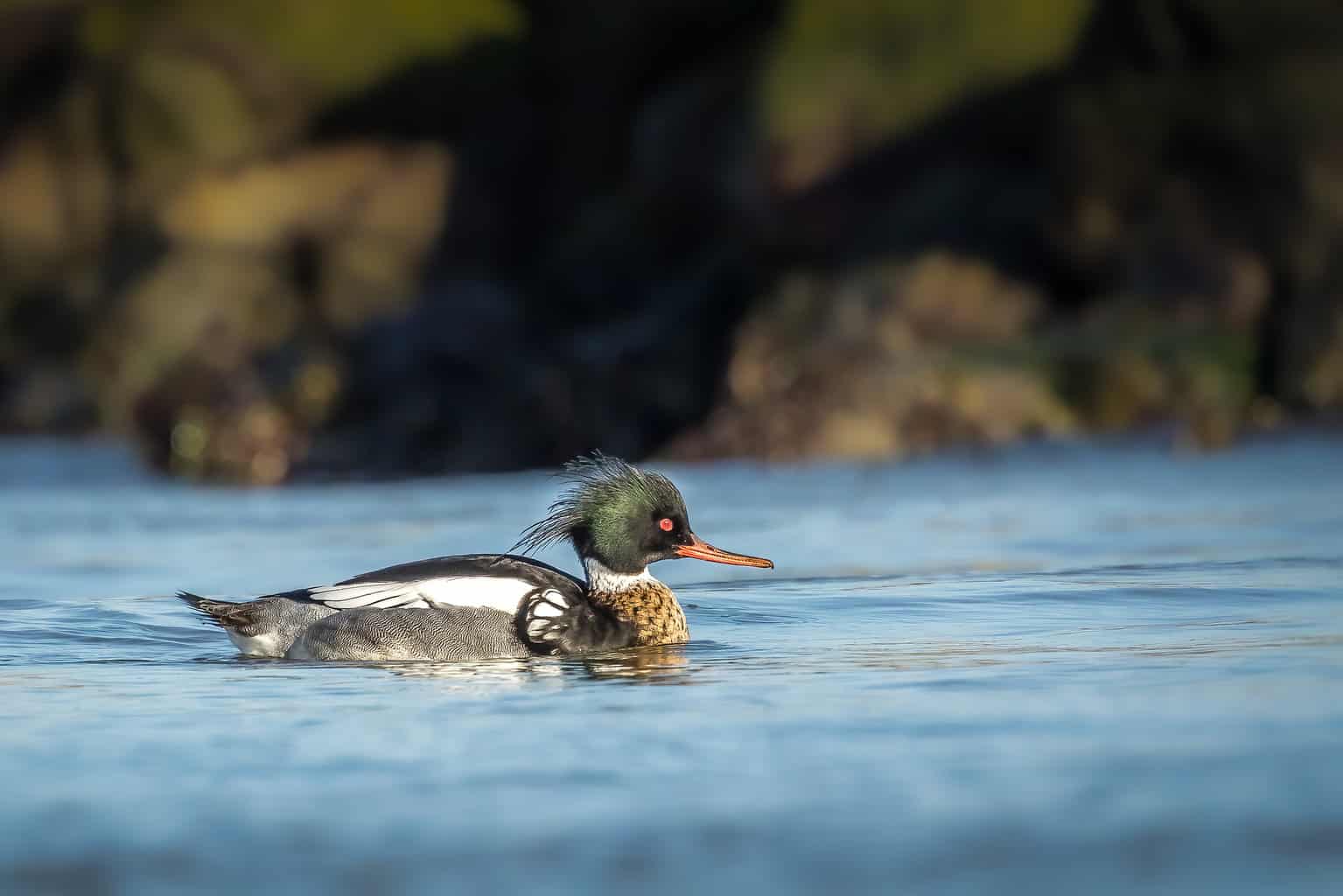
- Mergus serrator
- Length: 20.1-25.2 inches
- Weight: 28.2-47.6 ounces
- Wingspan: 26-29.1 inches
As winter begins, the coasts of Massachusetts start to fill with seasonal visitors. Among the species that flock to the state in large numbers each year is the red-breasted merganser.
Red-breasted mergansers are northern birds mostly of Canadian residence, with sparse breeding areas in the furthest northern stretches of the United States.
Males have the namesake red chest, although it’s not the brightest color red or the largest chest patch in the world of birds.
A white neck band separates the bird’s red chest from its green head, which contains wispy green plumage extending from the back. The male has a long, thin bill and glaring red eyes.
Females look very similar to female common mergansers. Female common mergansers have the aforementioned white chin patch, along with a whiter neck that meets the bird’s red head at a crisp, well-defined color border. The red-breasted merganser’s gray color extends up the neck until it starts to blend into its red head.
Hooded Merganser
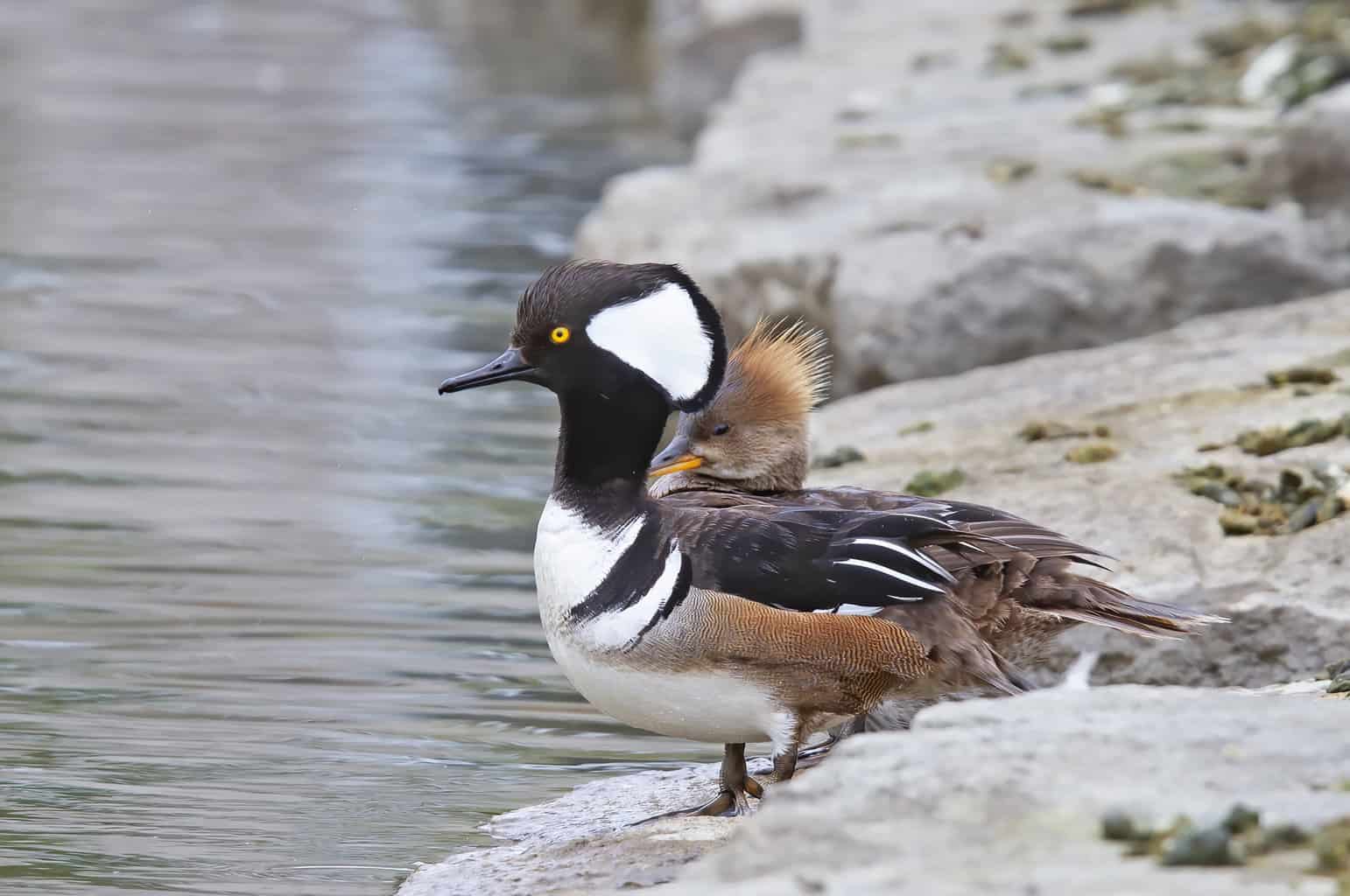
- Lophodytes cucullatus
- Length: 15.8-19.3 inches
- Weight: 16-31 ounces
- Wingspan: 23.6-26 inches
After two wintering mergansers, we come to the hooded merganser, a year-round and increasingly common resident of New England.
Nesting hooded mergansers require water in forested areas, as they nest in the holes of trees and snags.
In the winter, it’s not uncommon to see them along the coast, diving in bays and marshes near the water in search of fish and other food.
The hooded merganser’s top identifying characteristic is its large crest, which can either stand straight up in a full, rounded crest, or it can slump backward toward the body.
When a male’s crest is in full display, it’s 75 percent black with a white quarter wedge taken out of the backside. When it’s slumping backward, the white patch appears as a long, thick, white stripe.
The male has a white neck with brown sides and a mostly black back.
Females and both immature and non-breeding males are brown all over, with a crest that’s a tint redder than the rest of the body. You can tell a female from an immature or non-breeding male by their eye color. Males have yellow eyes. Females’ eyes are brown.
Common Eider
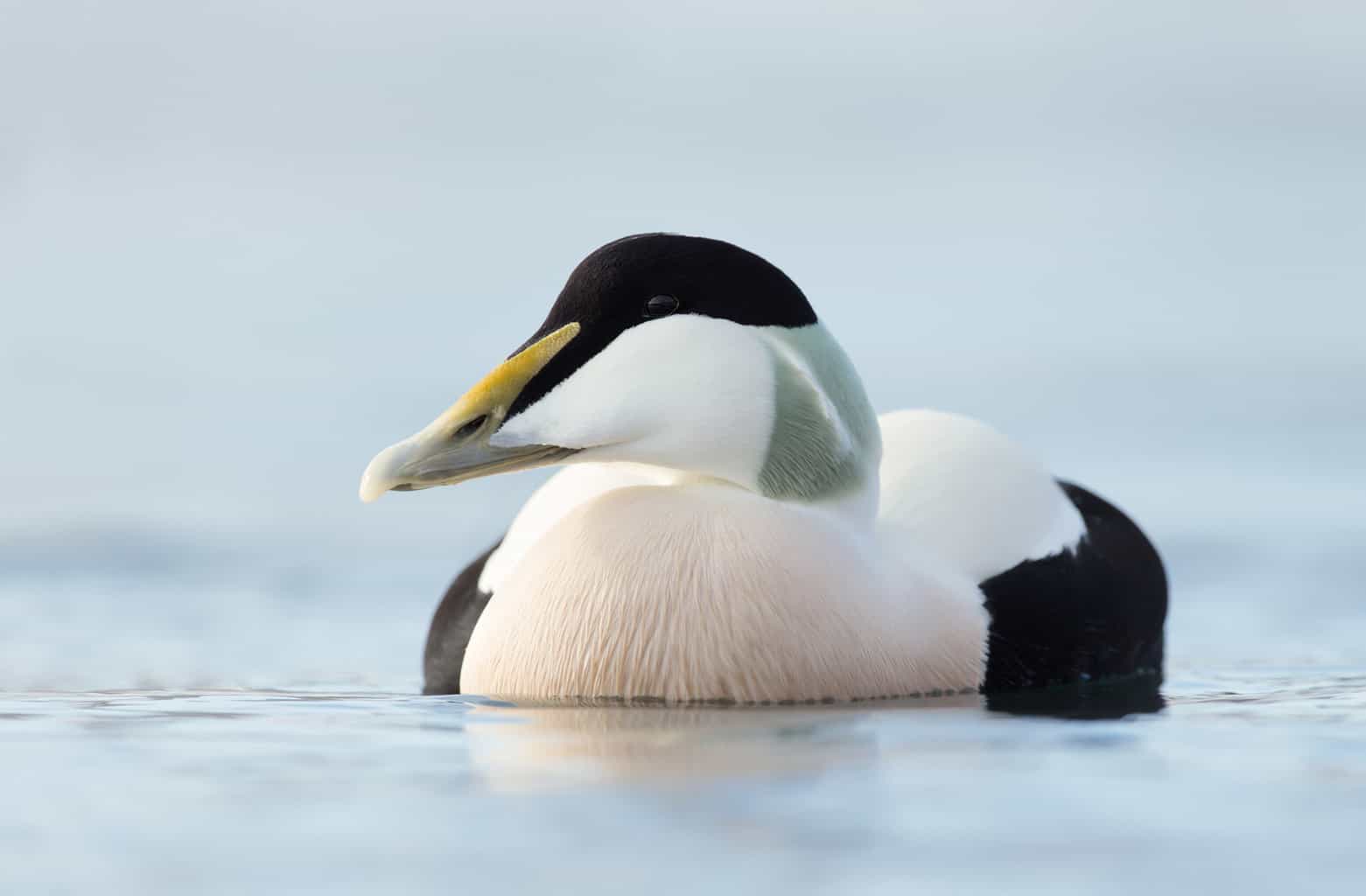
- Somateria mollissima
- Length: 19.7-28 inches
- Weight: 45.9-92.1 ounces
- Wingspan: 37.4-38.6 inches
Finally, we arrive at the eider and scoters on our journey through the ducks of the state, starting with the largest duck in the northern hemisphere, according to Ducks Unlimited.
Common eiders can weigh nearly six pounds, so seeing a sea duck that large is the first indication to help you settle on an eider identification.
The common eider breeds on northern coasts, although they are known to sometimes breed off the New England coast. Numbers increase significantly in the winter.
Males have white sides and chests, with green tints along the face and neck. A long black cap extends under the eye from the start of its bill to the back of the head.
Both males and females have a unique face shape, with a rather long, gradually sloped forehead from the top of the head down to the tip of the bill.
In eclipse plumage, they still have that green tint, but the rest of their body loses some of its crisp coloring, instead showing a mix of dark against white.
Females are an orange-tinged brown color over most of their bodies, with more of a standard brown on the wings. They have black barring throughout their body that’s fairly unique for a duck. It’s almost reminiscent of something you’d see on something like a grouse.
There are several subspecies of common eider, but the ones seen in Massachusetts would most likely be Dresser’s eiders.
King Eider
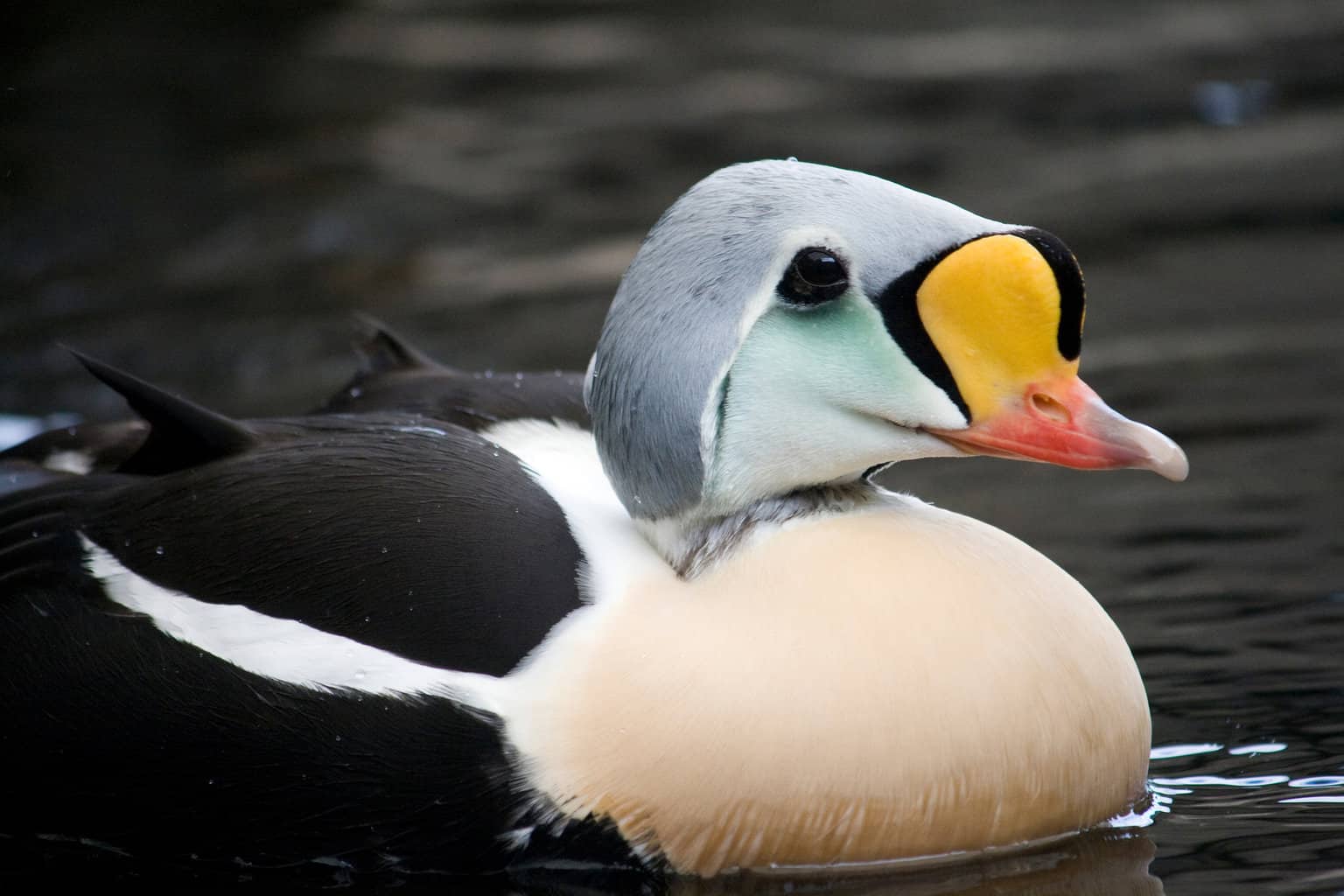
- Somateria spectabilis
- Length: 18.1-25.2 inches
- Weight: 42.3 to 74 ounces
- Wingspan: 35-40.2 inches
(Measurements courtesy of the University of Michigan’s BioKids)
The king eider is an uncommon sight along the Boston coast in the winter, so keep your ear to the ground with local bird reports to keep up with when locals are seeing them in a certain spot.
Joining local birding Facebook groups, checking eBird reports, and connecting with people through a local club are great ways to stay in the loop about which birds others are seeing and where they’re seeing them.
According to Mass Audubon, most of the king eiders seen in the state are immature birds or females.
Mature drakes have an odd head shape. They have a rather short and stubby bill because before the bill can even get started angling back up toward the face, it’s interrupted by a big orange knob that sticks up next to the eye.
Drakes have blue-gray caps and a face marked with a watered-down green color.
Females and immature males don’t have such odd shapes.
Hens are large brown ducks with black bills. They have pale, blocky faces overall, and could be confused with the common eider except for the sharply-contrasting black bill.
Immature males’ bills are a dull orange, and they’re mostly brown all over, with white intermixed on the chest area.
Surf Scoter
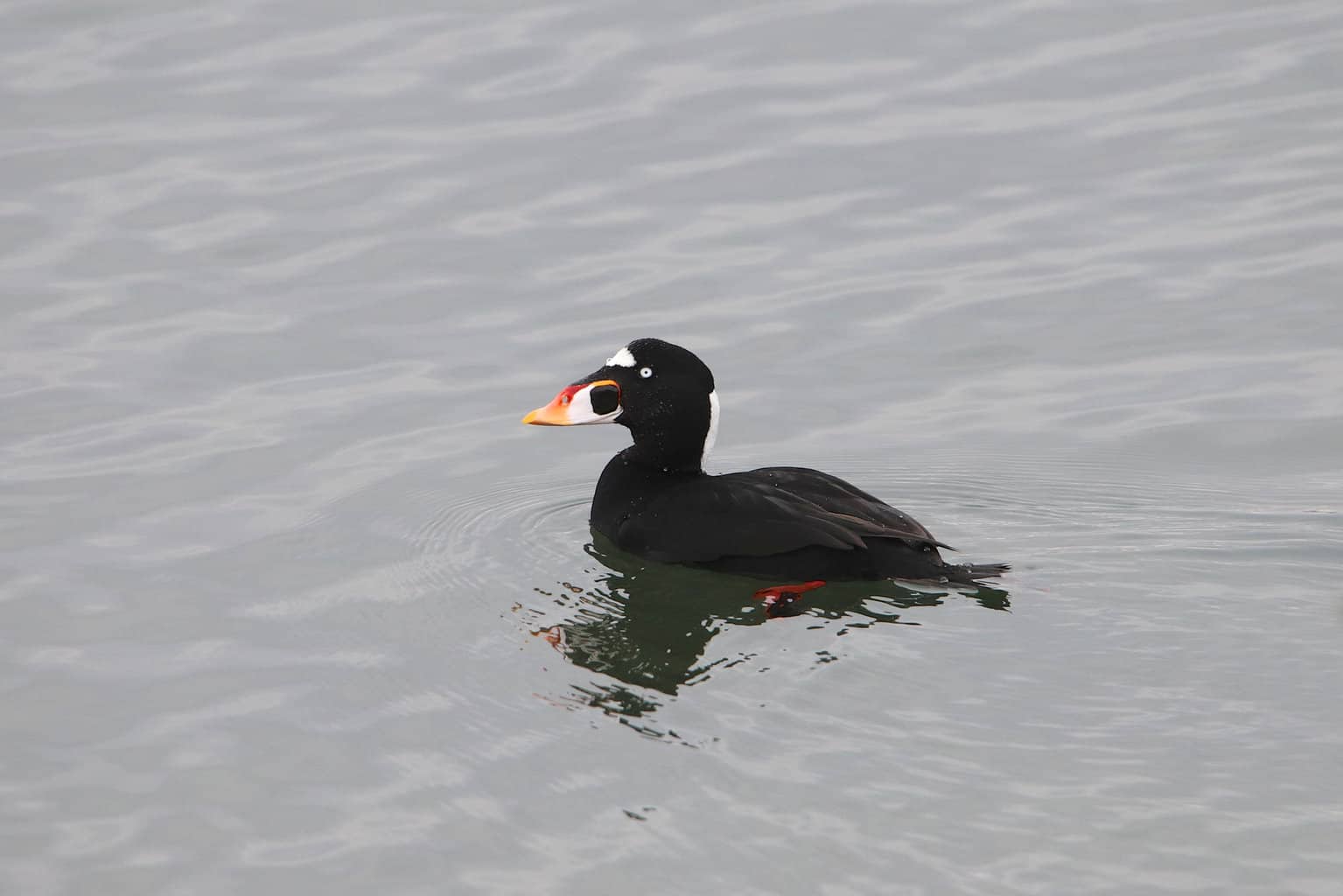
- Melanitta perspicillata
- Length: 18.9-23.6 inches
- Weight: 31.8-45.6 ounces
- Wingspan: 29.9-30.3 inches
Finally, we’re on to the scoters, another brand of sea duck that you may see off the Massachusetts shores. In the case of the surf scoter, it’s a bird that flocks to the state in pretty big numbers each winter, providing lots of opportunities for sightings.
Surf scoters are mostly black except for a couple of white patches: one on the nape and the other near the forehead. They have glaring white eyes and a bulky orange and white bill.
Females’ bills are the same shape, but all black instead of the standout orange and white. Their brown pattern is unremarkable, with two patches of white along the face. One is between the bill and the eye and the other is just behind the eye.
Those patches may be large or small and may come close to connecting just under the eye.
White-winged Scoter
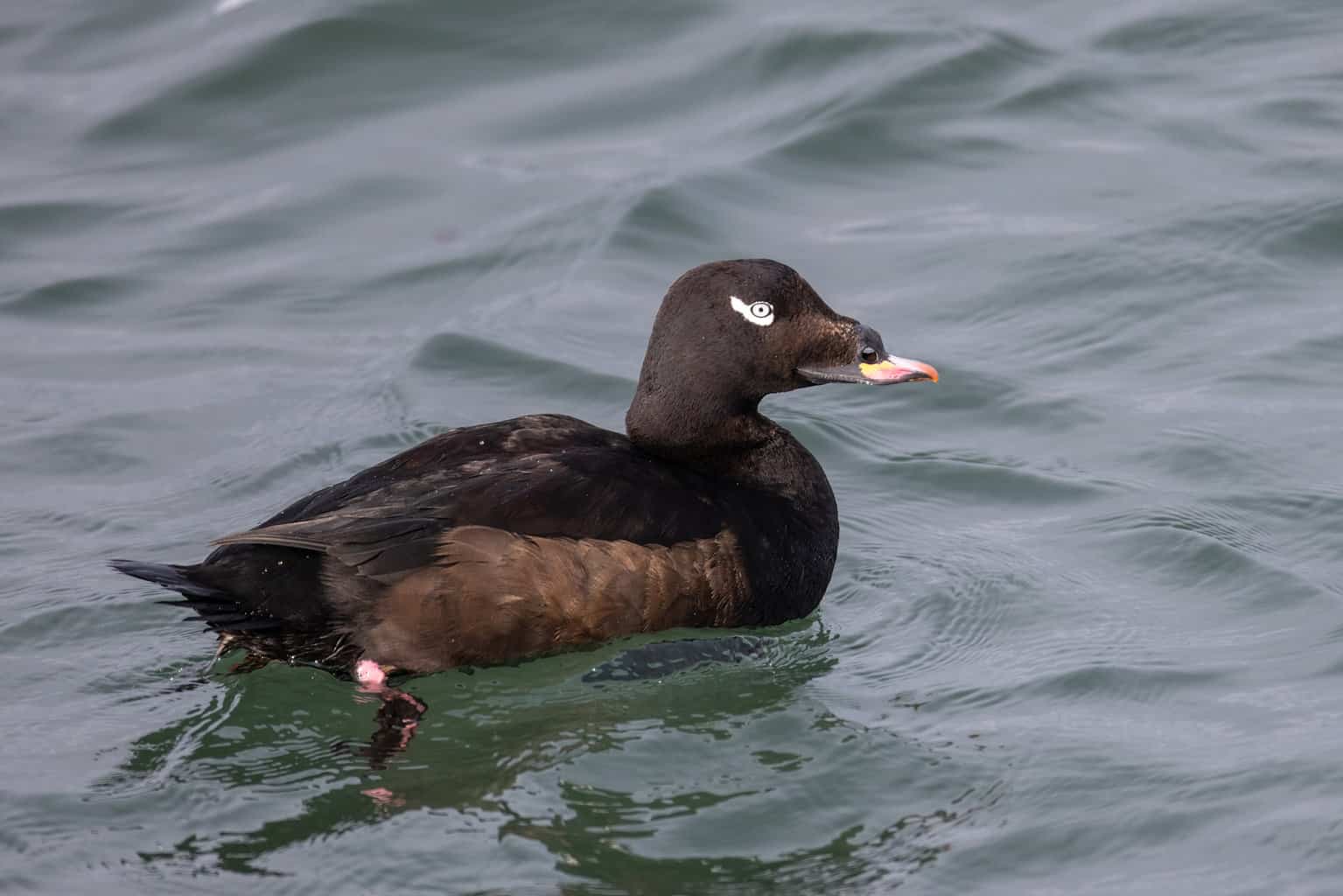
- Melanitta deglandi
- Length: 18.9-22.8 inches
- Weight: 33.5-63.5 ounces
- Wingspan: 31.5 inches
Another frequent visitor to the bays, coves, and coastlines of Massachusetts is the white-winged scoter. They can often be seen out on the saltwater in large groups.
Males are mostly black, with some white on their wings. It can look more like a stripe when sitting on the water, or like a larger patch in flight.
They have mostly black bills, including a black knob shape on an orange end. Around their white eyes, they have a splotch of white, like wing-tipped eyeliner.
Females are about the same size as surf scoters, mostly brown, with a white wing patch, as the name suggests. They also have two white patches, one on either side of the eye, but they’re both larger and more circular than the surf scoter’s two white patches.
Black Scoter
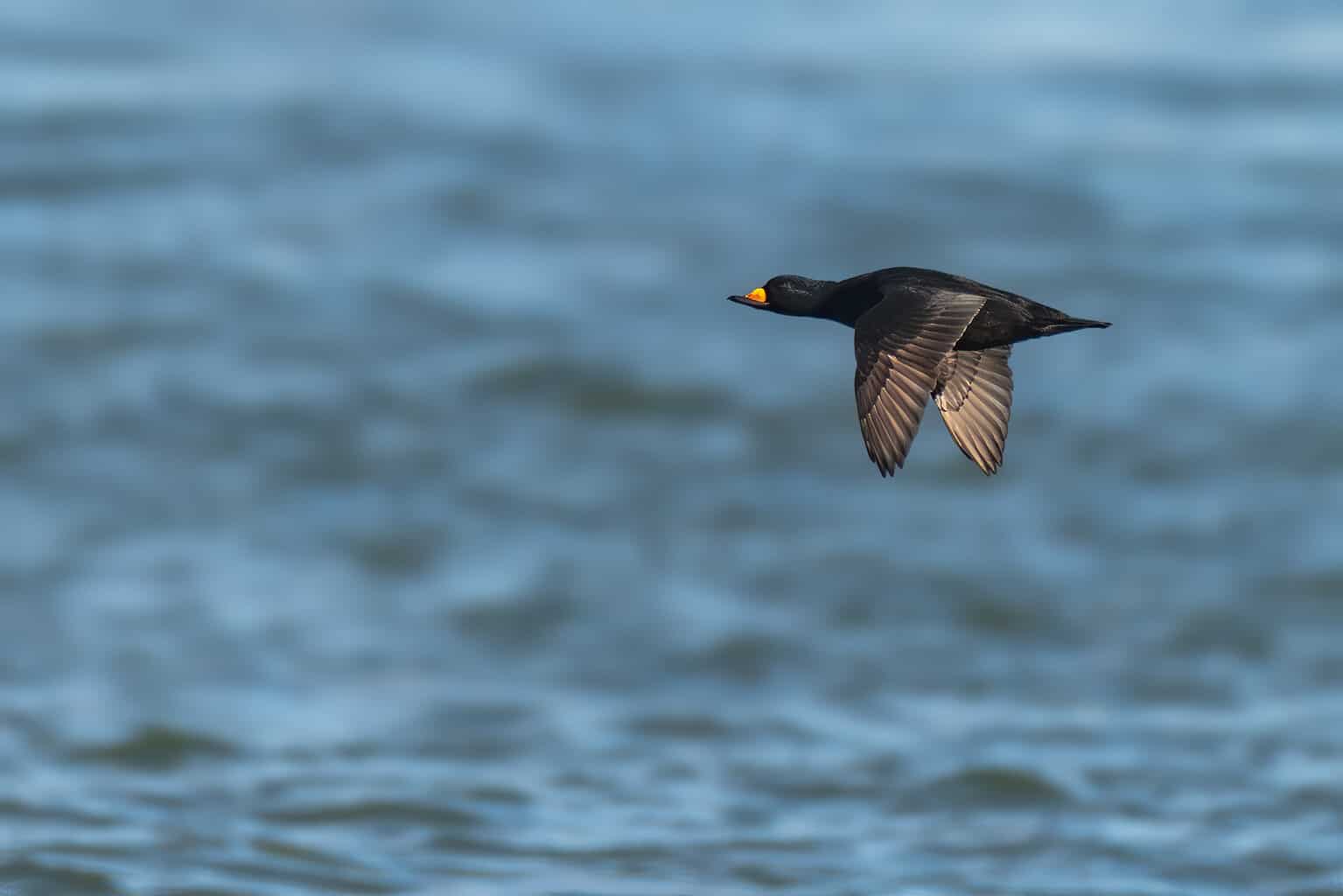
- Melanitta americana
- Length: 16.9-19.3 inches
- Weight: 30.4-38.8 ounces
- Wingspan: 27.6-28.4 inches
The final bird on our list is the smallest of the three North American scoters, typically smaller than a mallard.
Like other scoters, black scoters are seen almost exclusively on the ocean or, at a minimum, very close to it. Like white-winged scoters, they may be seen in large flocks, intermingling with other ducks.
The drakes of this sea duck species are all black except for an orange-yellow knob on top of a black bill.
Females are shaped similarly to other ducks, with a dark brown body, a light brown face, and a cap that gets darker right at the eye line. They have black bills.

